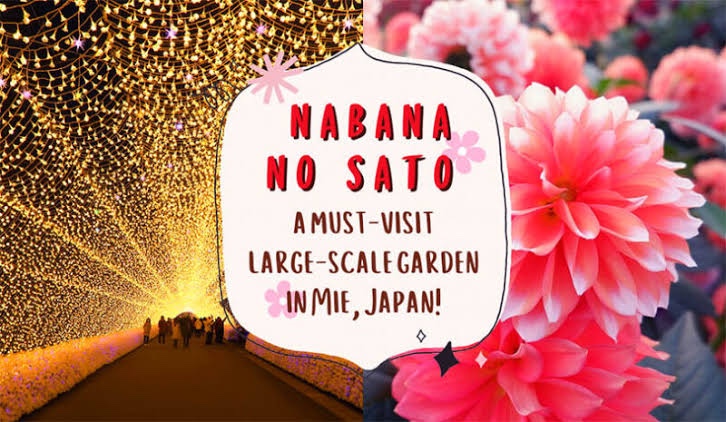 The Nabano no Sato illuminated gardens are a ‘must visit’ when in Nagano so I figured we needed to go visit. Given it was all happening after hours, it wasn’t too hard to set aside the evening to go out and see them. The gardens are actually attached to an enormous plant nursery and they have been lighting up paths and expanding on the attraction for years. At 2500JPY per person for the entrance fee, it’s not so cheap to just wander around and look at the lights, but it weirdly includes 1000JPY per person in vouchers that you can spend inside the park…
The Nabano no Sato illuminated gardens are a ‘must visit’ when in Nagano so I figured we needed to go visit. Given it was all happening after hours, it wasn’t too hard to set aside the evening to go out and see them. The gardens are actually attached to an enormous plant nursery and they have been lighting up paths and expanding on the attraction for years. At 2500JPY per person for the entrance fee, it’s not so cheap to just wander around and look at the lights, but it weirdly includes 1000JPY per person in vouchers that you can spend inside the park… 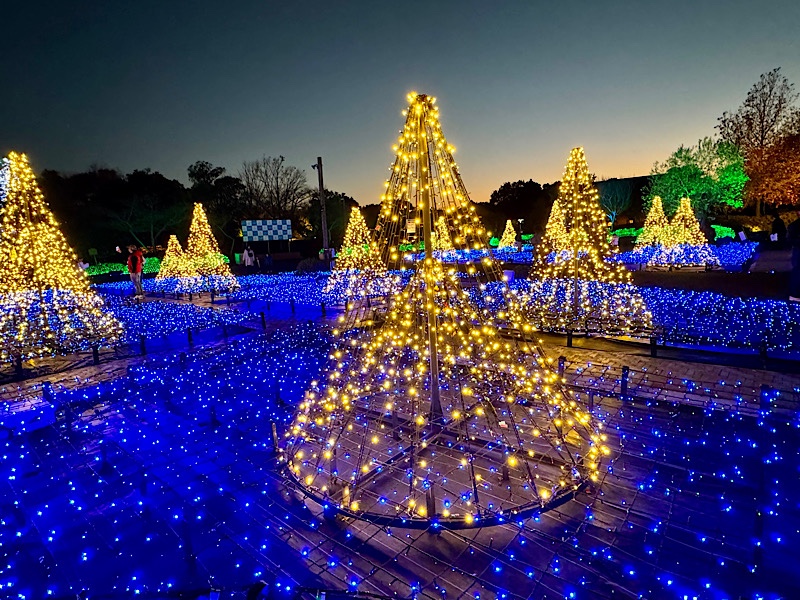
… and there are multiple restaurants (and even a loosely German style beer hall) and gift shops contained in the park where you can spend your vouchers. It’s almost like ‘here, buy a ticket and we will give you a modest free meal with it). The park consists of acres of displays, comprised of millions of twinkly lights… or fairy lights as we tend to call them in Australia. 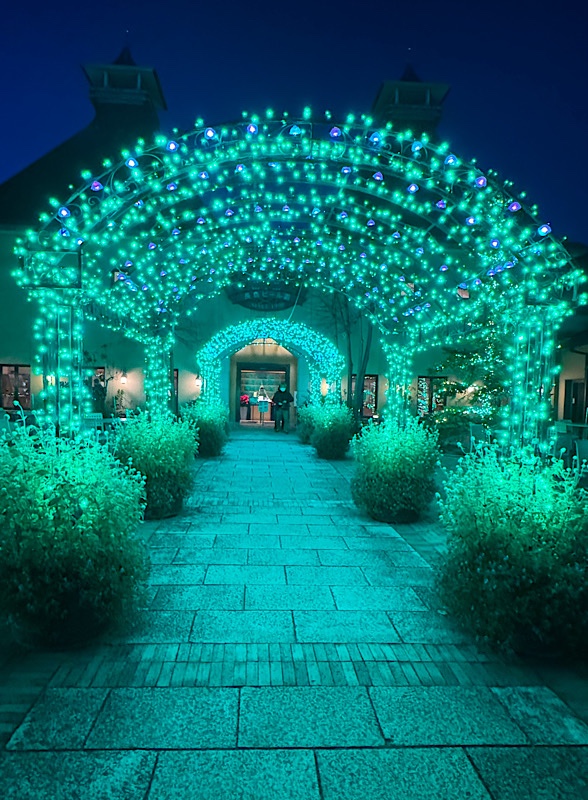 Having read up on the place before coming out here, we arrived just before sunset and had a bite to eat- from what I’ve read and now from what I’ve seen, if you go wander through the park first if you want something to eat a bit later, you’ll be lining up for ages to get seated in any of the park’s restaurants. The place was BUSY – and the 5400 space car park was no where near full.
Having read up on the place before coming out here, we arrived just before sunset and had a bite to eat- from what I’ve read and now from what I’ve seen, if you go wander through the park first if you want something to eat a bit later, you’ll be lining up for ages to get seated in any of the park’s restaurants. The place was BUSY – and the 5400 space car park was no where near full.
I had a seafood dorai dish that was like a mornay, but at the same time tasted nothing like a mornay. 🙂 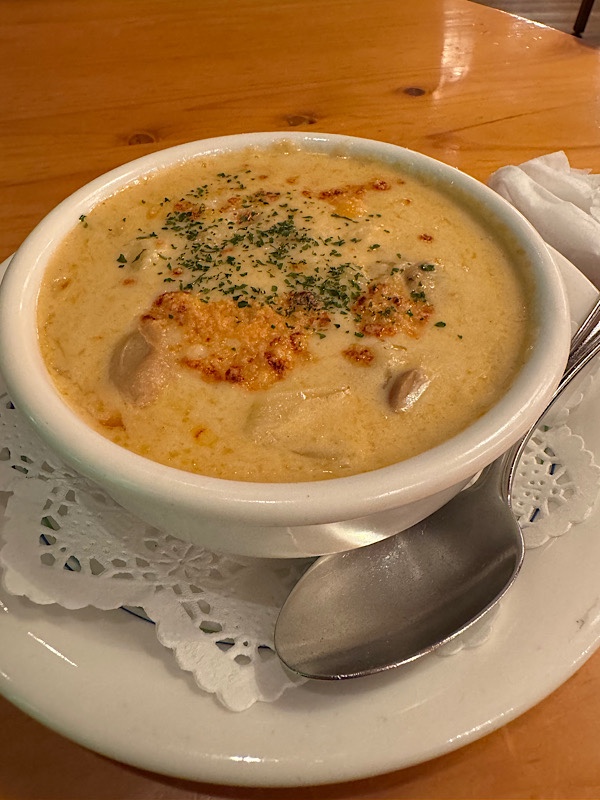 Mr K ordered a park katsu curry that was served in a huge cube of bread with a miso curry and egg. The curry was really tasty… miso curry is a popular thing in the Nagano region.
Mr K ordered a park katsu curry that was served in a huge cube of bread with a miso curry and egg. The curry was really tasty… miso curry is a popular thing in the Nagano region.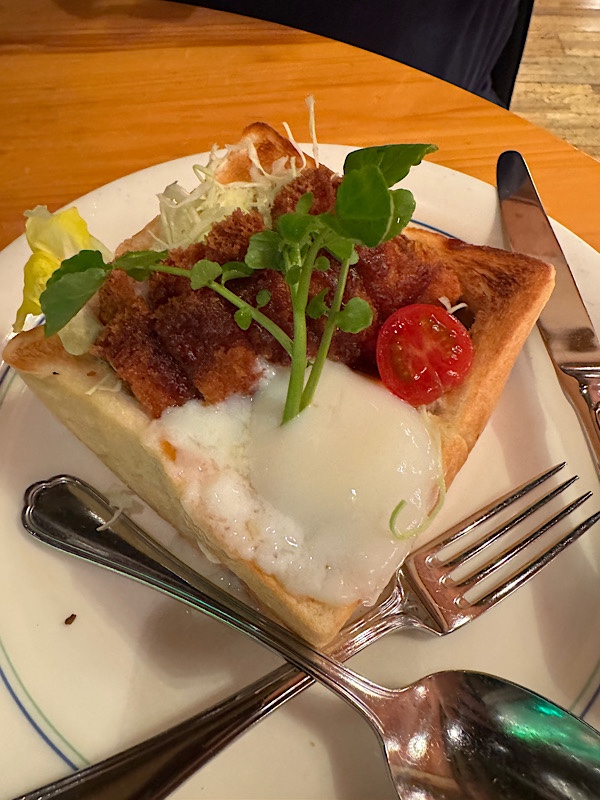 I also ordered some saké – because well, every time I look at a menu and there are no diet soft drink options, I think ‘I’ve gonna have the sugar, I may as well have the alcohol!’. This is the FIRST time ever that I have been served hot saké in Japan. Honestly, all the brewery and saké shops, and restaurants we have been to – the saké is, by default, chilled. With this one exception.
I also ordered some saké – because well, every time I look at a menu and there are no diet soft drink options, I think ‘I’ve gonna have the sugar, I may as well have the alcohol!’. This is the FIRST time ever that I have been served hot saké in Japan. Honestly, all the brewery and saké shops, and restaurants we have been to – the saké is, by default, chilled. With this one exception.  Which got me wondering why…
Which got me wondering why… 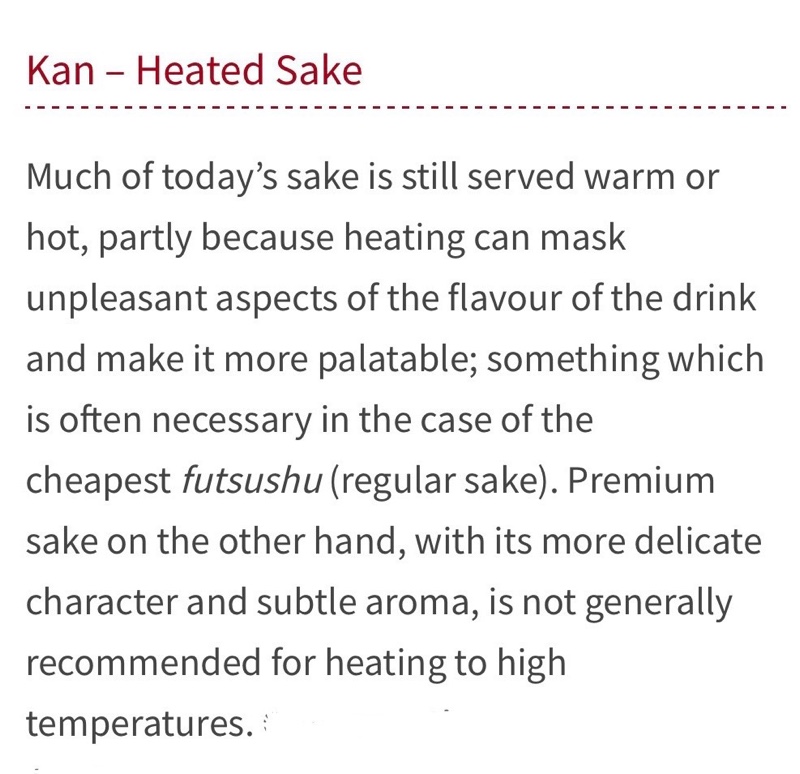 I actually asked for some ice to cool it down and see what it tasted like, as while it was hot all I could pick out was the heavy tone of ‘this is alcohol’… and yeah, it was not sweet, not dry, not citrusy, not floral, it was just kinda bland. So I can see why they heated it up.
I actually asked for some ice to cool it down and see what it tasted like, as while it was hot all I could pick out was the heavy tone of ‘this is alcohol’… and yeah, it was not sweet, not dry, not citrusy, not floral, it was just kinda bland. So I can see why they heated it up.  Through the large park is an enormous stream of hot onsen water lined with beautiful Japanese maple trees. There was a public onsen for bathing if that took your fancy, as well as further in a very popular onsen foot bath which had crowds of people using it. The stream made for some glorious opportunities for reflection photographs. But it was very hard to capture the beauty of the scene…
Through the large park is an enormous stream of hot onsen water lined with beautiful Japanese maple trees. There was a public onsen for bathing if that took your fancy, as well as further in a very popular onsen foot bath which had crowds of people using it. The stream made for some glorious opportunities for reflection photographs. But it was very hard to capture the beauty of the scene… 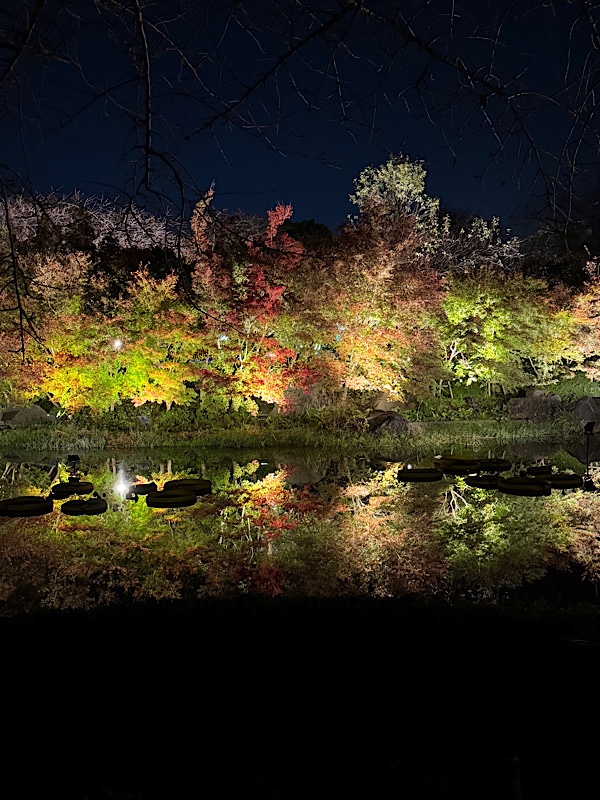 Though I repeatedly tried to! So many photos of the same subject. 🙂
Though I repeatedly tried to! So many photos of the same subject. 🙂  There was also an enormous lake which led up to what looked like a Christian church – an yes, you can have weddings out here, or just come out and having wedding photos taken in the park. It’s popular all year round for the autumn leaves and also for the cherry blossoms and massive begonia fields.
There was also an enormous lake which led up to what looked like a Christian church – an yes, you can have weddings out here, or just come out and having wedding photos taken in the park. It’s popular all year round for the autumn leaves and also for the cherry blossoms and massive begonia fields.  Attempt 53 at trying to captures the reflections of the autumn leaves in the lake…
Attempt 53 at trying to captures the reflections of the autumn leaves in the lake…
A little better…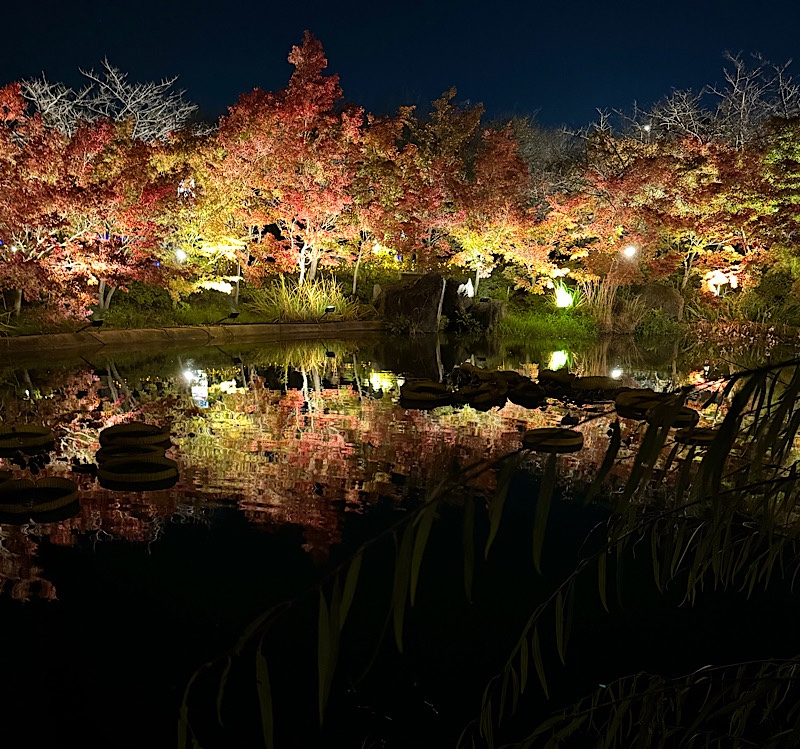
Then there was the huge 300m long tunnel of twinkle lights which seemed to be selfie haven for visitors…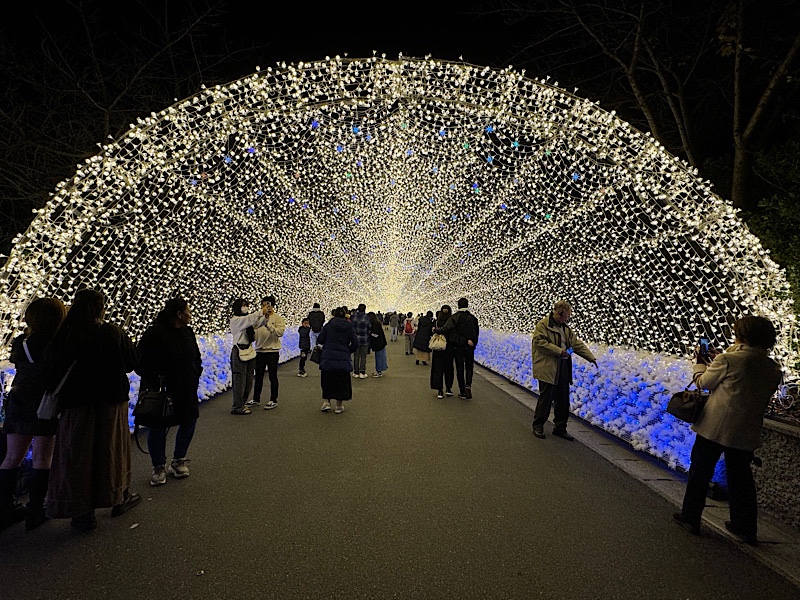
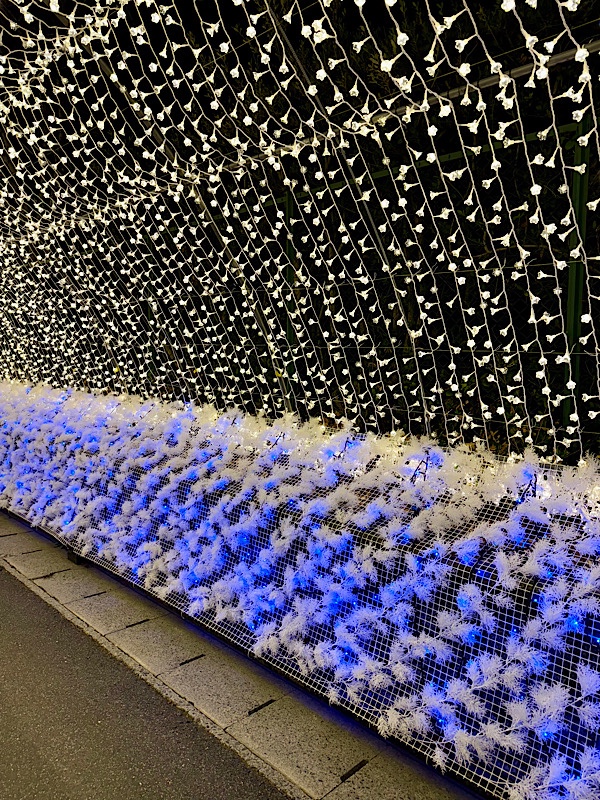
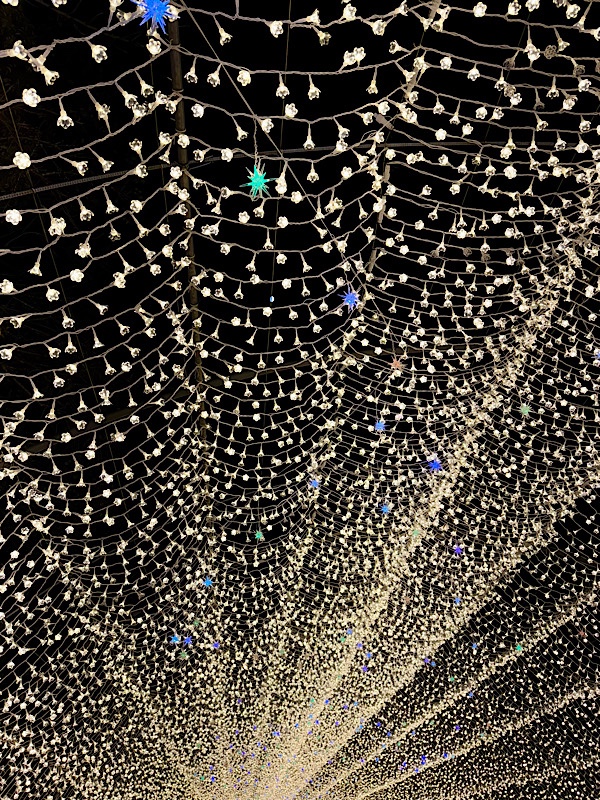
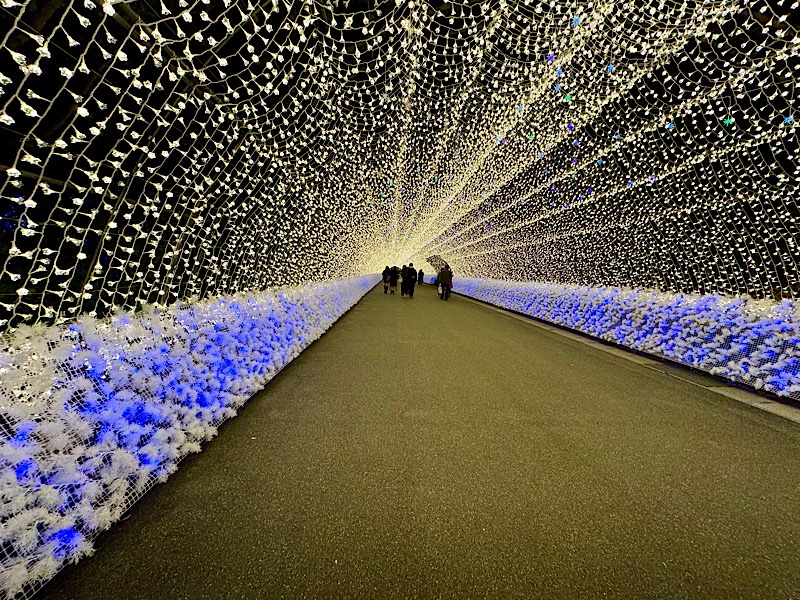 It was actually really pretty which got me wondering why the hell do people like twinkle/fairy lights so much? What bower-bird like instinct is driving this?
It was actually really pretty which got me wondering why the hell do people like twinkle/fairy lights so much? What bower-bird like instinct is driving this?
According to WebMD – the ultimate source of reliable medical and psychological information on the entire internet (lol) – string lights or twinkle lights can make us feel more connected to one another, boosting one’s mood and make us feel more hopeful.
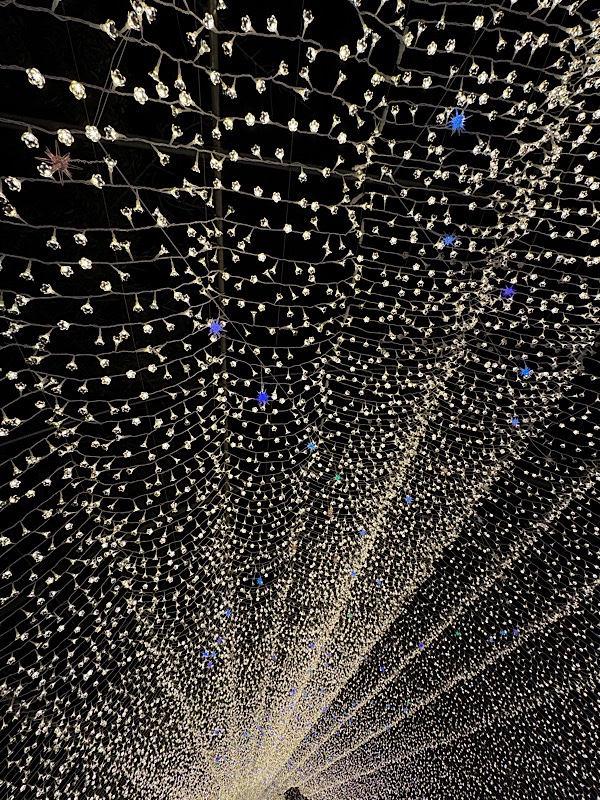
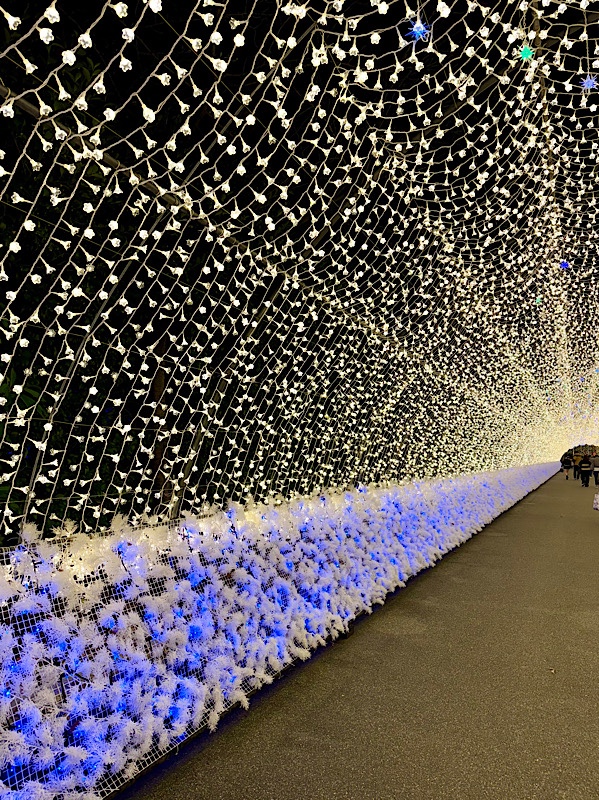
The reason they seem to make people feel happier has to do with the release of dopamine apparently – and is fairly heavily connected to memories of colourful holiday lights making us feel good as children. There’s actually a type of colour therapy called chromotherapy where people with anxiety and depression are encouraged to spend time in spaces with coloured or decorative lights to pump up the dopamine.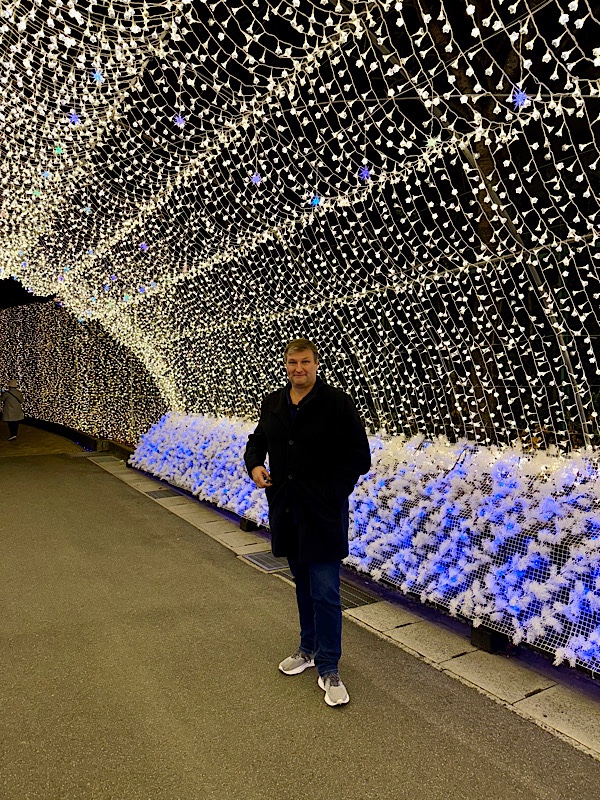
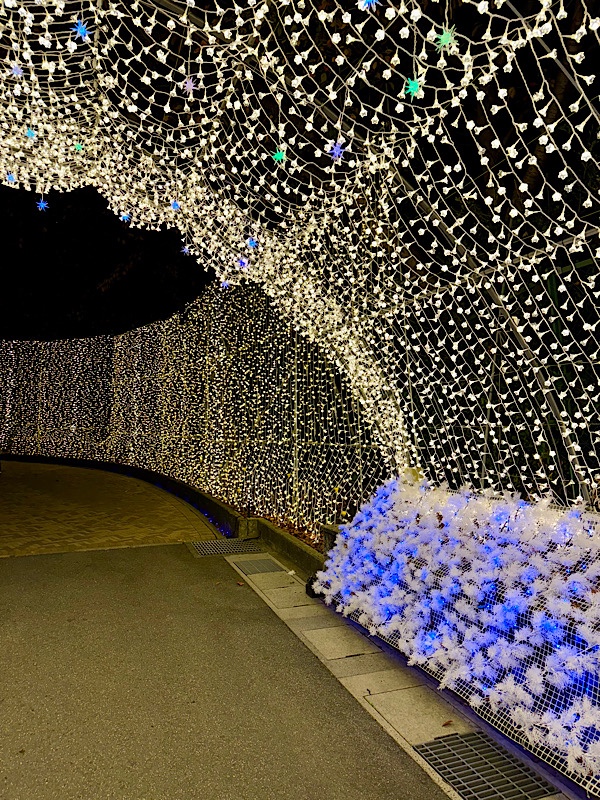 So we’re not all just a bunch of nutters flocking to a Nagoya plant nursery for no reason – we’re psychologically drawn to them. 😉 #sciencebitches
So we’re not all just a bunch of nutters flocking to a Nagoya plant nursery for no reason – we’re psychologically drawn to them. 😉 #sciencebitches 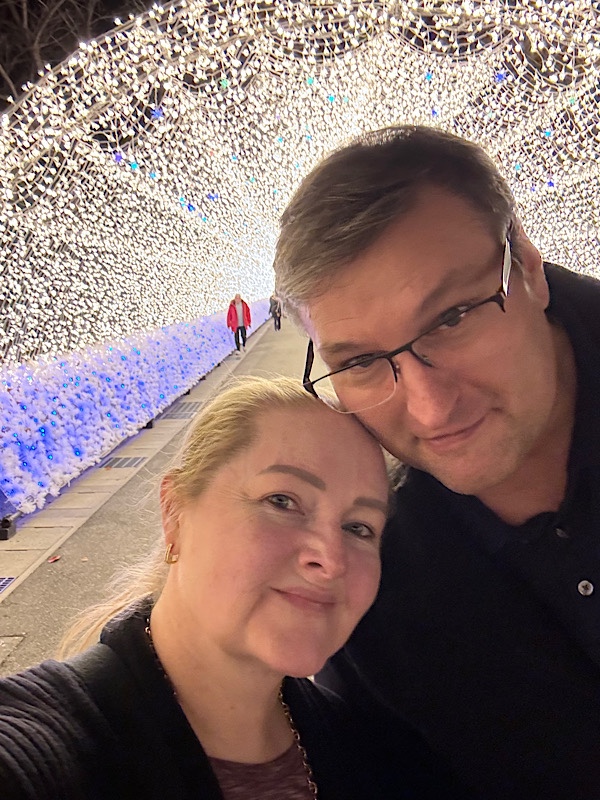
At the end of the big long selfie tunnel was an enormous field with pathways meandering towards three huge pyramids. Why pyramids you might ask? Well, I know I was wondering and nothing I saw gave an answer.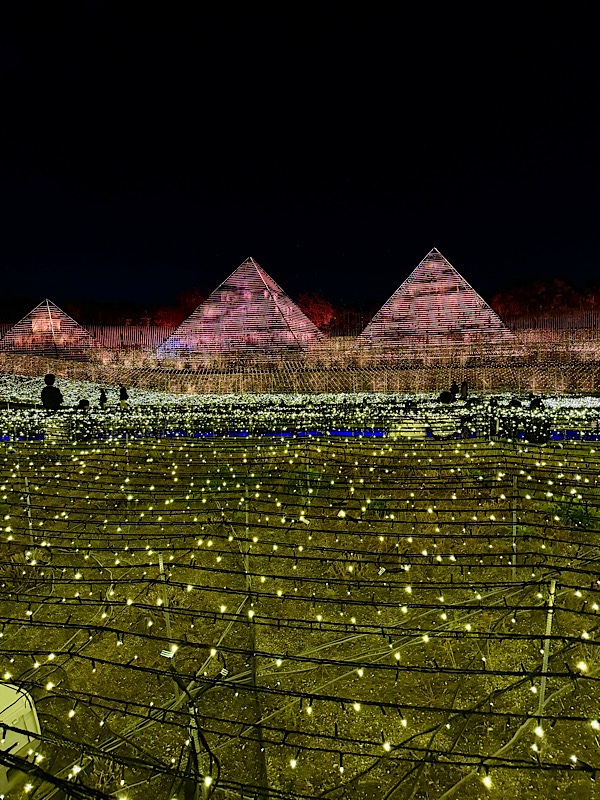
Probably something mundane, like large temporary structures are more stable when they are triangular or something. 😉 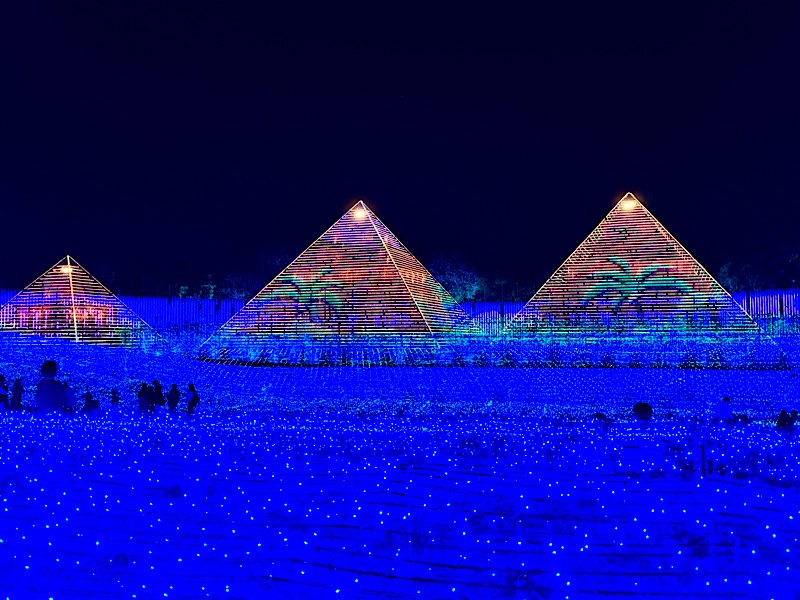

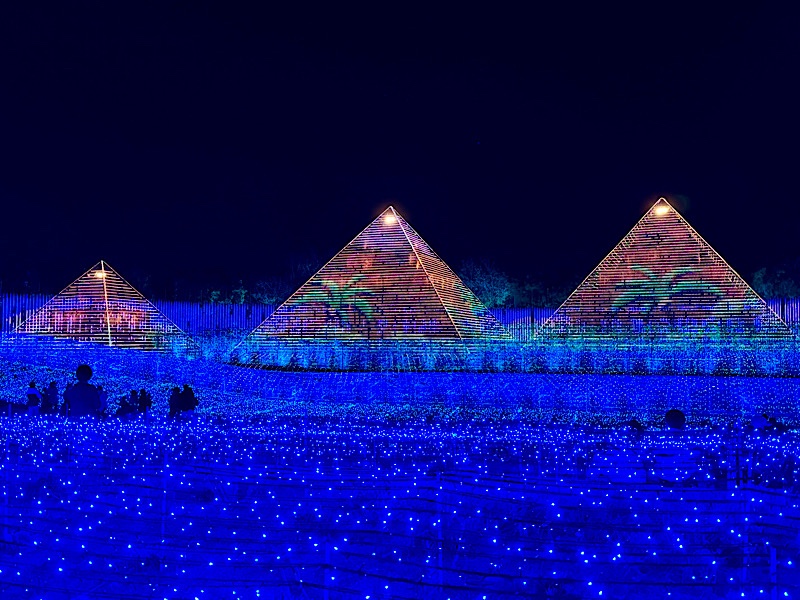
I kept wondering though (because I’m ever the pragmatist and quite the glass half empty kinda gal) how crap this must look in the daylight if my neighbour’s yards are anything to go by when they have their Christmas lights up!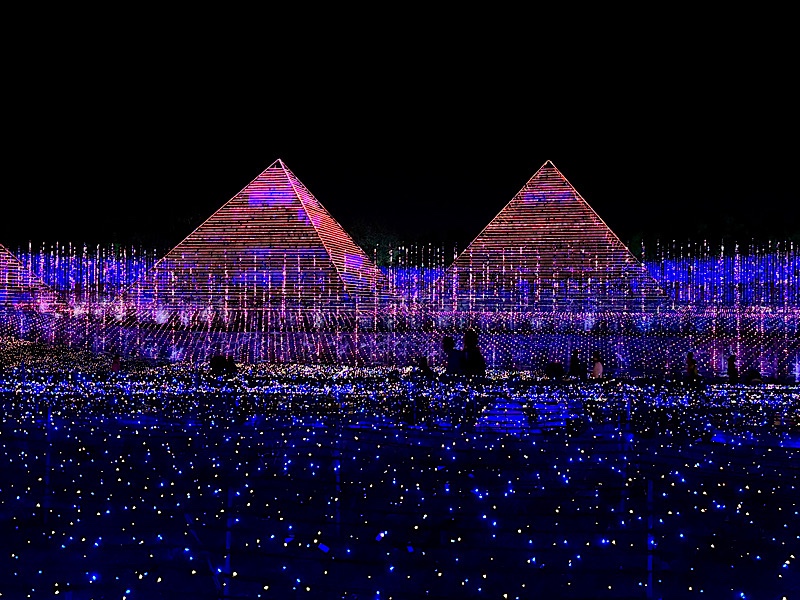
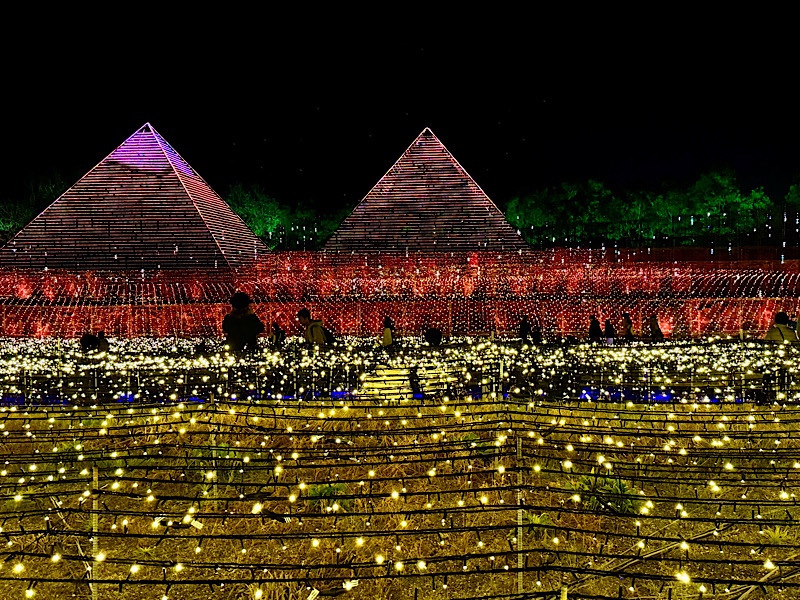 Ahhhh… a tunnel of love hearts.
Ahhhh… a tunnel of love hearts.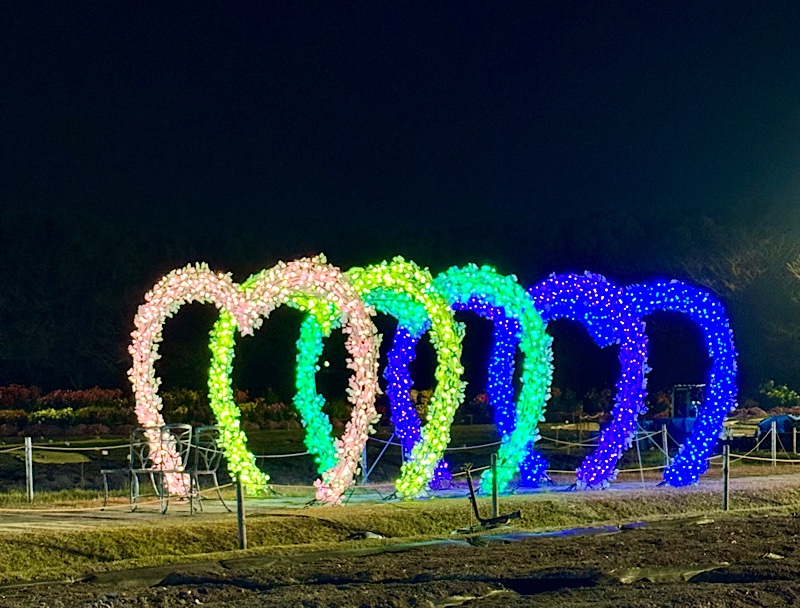 In front of which you can get a professional photograph with your sweetie.
In front of which you can get a professional photograph with your sweetie. 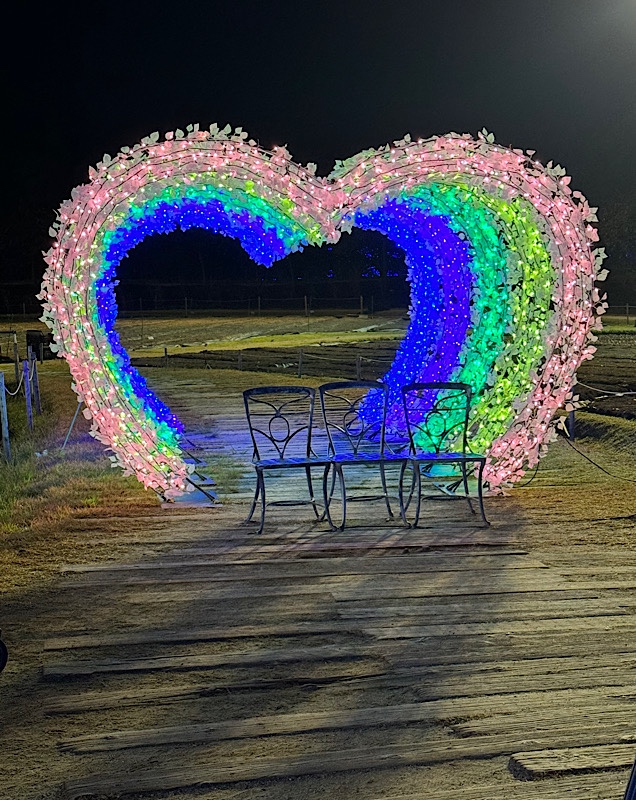 Another tunnel – this time made to look like draping wisteria.
Another tunnel – this time made to look like draping wisteria.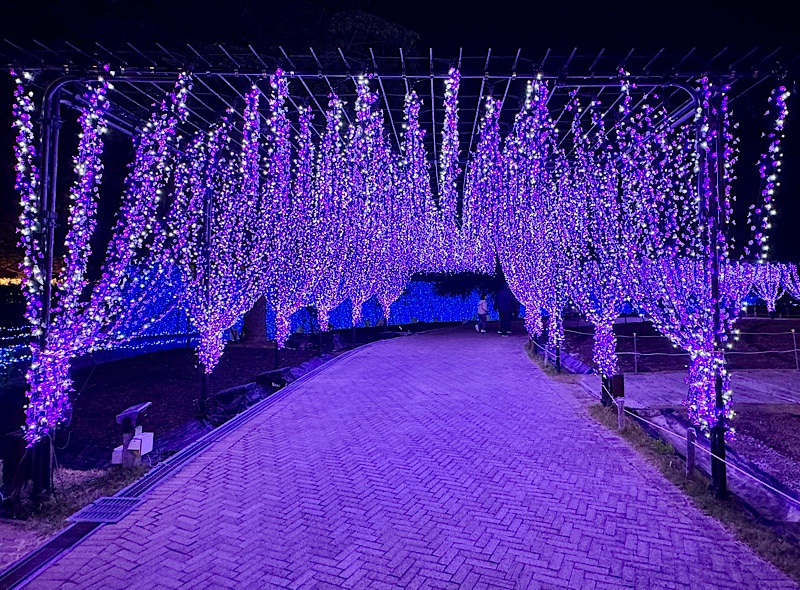 But the most adorable was for last – the long flower tunnel leading back around to the lake… there were two little boys running around with us in tiny little Santa suits. Their Mum chasing them with a large camera trying to get a Christmas photo of her little darlings. They were so excited and happy and much to excited to sit together for more than a fraction of a second for poor Mum to take their photo. They were so cute!
But the most adorable was for last – the long flower tunnel leading back around to the lake… there were two little boys running around with us in tiny little Santa suits. Their Mum chasing them with a large camera trying to get a Christmas photo of her little darlings. They were so excited and happy and much to excited to sit together for more than a fraction of a second for poor Mum to take their photo. They were so cute! 
Waiting for the lights to change making the tunnel look like it was made up of different flowers! Magical. 😛
 Obligatory selfie…
Obligatory selfie…
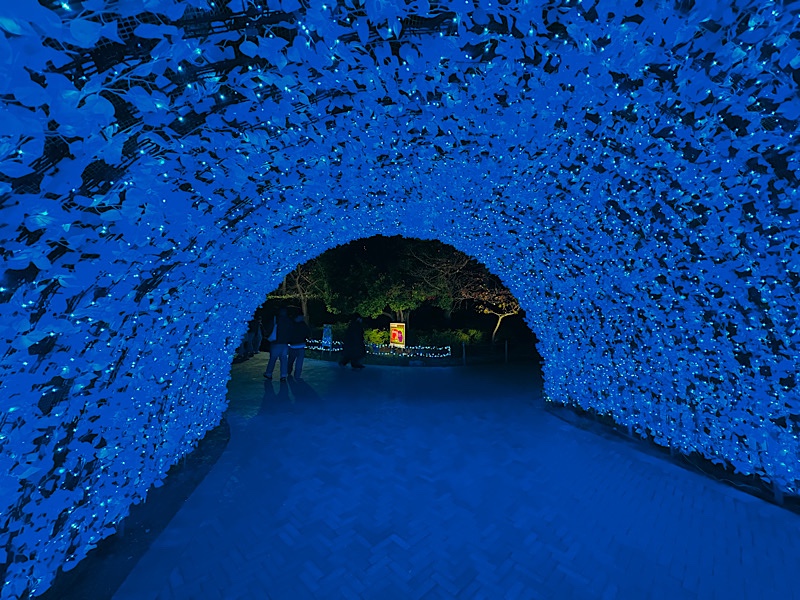
And then it was time to make our way out of the park. It was well worth a visit, even if it is quite the most Japanese-twee touristy thing we have done this entire trip… much better than a Robot Restaurant imo. 😉



 Traditional feudal map of the Nagoya area… could not ascertain from the description when it was created or by whom.
Traditional feudal map of the Nagoya area… could not ascertain from the description when it was created or by whom. Ooh, pretty garden visible from one of the internal passage ways between exhibition halls.
Ooh, pretty garden visible from one of the internal passage ways between exhibition halls.












 Multiple beds of irises that must look amazing in the spring.
Multiple beds of irises that must look amazing in the spring.






 Children crossing warning signs here are slightly more fun than at home: “Be careful; jumping out!!”
Children crossing warning signs here are slightly more fun than at home: “Be careful; jumping out!!” 

 I thought this would be the highlight of the autumn colours today.
I thought this would be the highlight of the autumn colours today.

 One of the things I have noticed here on Japan’s roadways is the total lack of ‘lookout’ points. In Australia there are spaces on highways and roads to pull over and see nice scenery all over the place – they are quite often marked on maps as scenic or photo-worthy stops. Here, there is rarely anything like that, even though the scenery is quite often spectacular.
One of the things I have noticed here on Japan’s roadways is the total lack of ‘lookout’ points. In Australia there are spaces on highways and roads to pull over and see nice scenery all over the place – they are quite often marked on maps as scenic or photo-worthy stops. Here, there is rarely anything like that, even though the scenery is quite often spectacular.
 The autumn colours were simply stunning against the deep blue/green of this lake/river.
The autumn colours were simply stunning against the deep blue/green of this lake/river.

 *if we ignore the fact that I’m standing on the side of a highway and cars are flying past us at breakneck speed.
*if we ignore the fact that I’m standing on the side of a highway and cars are flying past us at breakneck speed. 







 When I was making arrangements for this trip back in April, I had originally intended to stay a couple of nights in a more Western style hotel closer to the old part of Takayama where the transport issues are – until I saw a Japanese video posted by someone who had stayed at this ryokan. It just looked amazing and I have been looking forward to it for six months.
When I was making arrangements for this trip back in April, I had originally intended to stay a couple of nights in a more Western style hotel closer to the old part of Takayama where the transport issues are – until I saw a Japanese video posted by someone who had stayed at this ryokan. It just looked amazing and I have been looking forward to it for six months.  The entrance to the hotel is fairly unassuming – perfectly manicured gardens are ‘de rigeur’ here and seem quite common everywhere.
The entrance to the hotel is fairly unassuming – perfectly manicured gardens are ‘de rigeur’ here and seem quite common everywhere.  But just on the other side of those shrubberies is a world all of its own… a large koi pond featuring equally large koi. A cute little walkway over the pond which leads to and onsen foot bath (fresh hot mineral waters piped into a knee deep bath where you can remove your socks and shoes and soak your weary feets).
But just on the other side of those shrubberies is a world all of its own… a large koi pond featuring equally large koi. A cute little walkway over the pond which leads to and onsen foot bath (fresh hot mineral waters piped into a knee deep bath where you can remove your socks and shoes and soak your weary feets).  An outdoor lounging area that wasn’t seeing much use given it was max temps of 10-11C while we were here and lows of 4C and 2C overnight.
An outdoor lounging area that wasn’t seeing much use given it was max temps of 10-11C while we were here and lows of 4C and 2C overnight.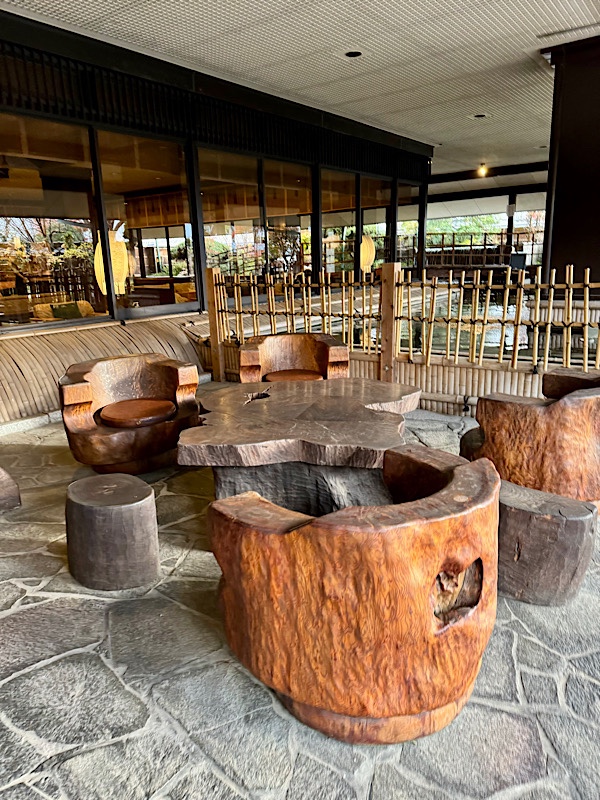
 We were welcomed by a lovely young lady named Kyaka, who checked us in, brought us some drinks, hot towels and showed us through the quiet and dimly lit hallway to our room.
We were welcomed by a lovely young lady named Kyaka, who checked us in, brought us some drinks, hot towels and showed us through the quiet and dimly lit hallway to our room. The decor was very traditional, except for the slightly elevated futon beds. In the room waiting for us was some snacks, and green tea and an explanation of where to find things in the room – yukata and jinbei (Japanese style pyjamas) to wear, a bunch of amenities for us, and an opportunity to specify what time we would like to have dinner and breakfast etc.
The decor was very traditional, except for the slightly elevated futon beds. In the room waiting for us was some snacks, and green tea and an explanation of where to find things in the room – yukata and jinbei (Japanese style pyjamas) to wear, a bunch of amenities for us, and an opportunity to specify what time we would like to have dinner and breakfast etc.  The bathroom was neat and all panelled in fresh cypress – it smelled amazing!
The bathroom was neat and all panelled in fresh cypress – it smelled amazing! 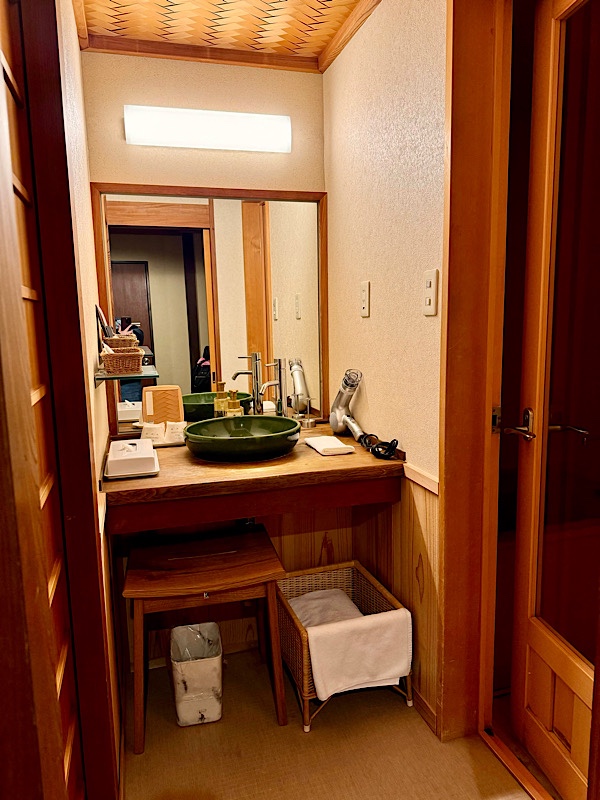
 But the best bit… omg! So excited – was the stonking huge granite onsen bath in our own private garden. <3 I couldn’t wait for Kyaka to finish her introduction so we could have a shower, scrub up and then slide into this amazingly beautiful bath in this cute little garden space.
But the best bit… omg! So excited – was the stonking huge granite onsen bath in our own private garden. <3 I couldn’t wait for Kyaka to finish her introduction so we could have a shower, scrub up and then slide into this amazingly beautiful bath in this cute little garden space.  The bath was a steady 40-41C and was just bliss. The water at this particular onsen comes from 1200 feet below ground and is particularly high in minerals which make the water so soft it feels kinda slippery… it was so steamy as the ambient temperature was only about 8C or so.
The bath was a steady 40-41C and was just bliss. The water at this particular onsen comes from 1200 feet below ground and is particularly high in minerals which make the water so soft it feels kinda slippery… it was so steamy as the ambient temperature was only about 8C or so. In what is now become quite our usual habit, we shared some saké acquired on our way to the ryokan and had a good soak. Love it!
In what is now become quite our usual habit, we shared some saké acquired on our way to the ryokan and had a good soak. Love it!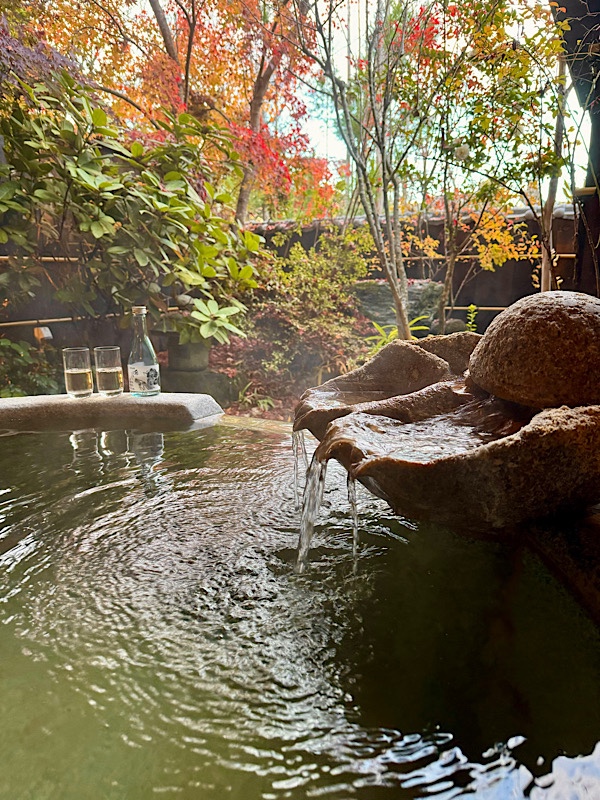
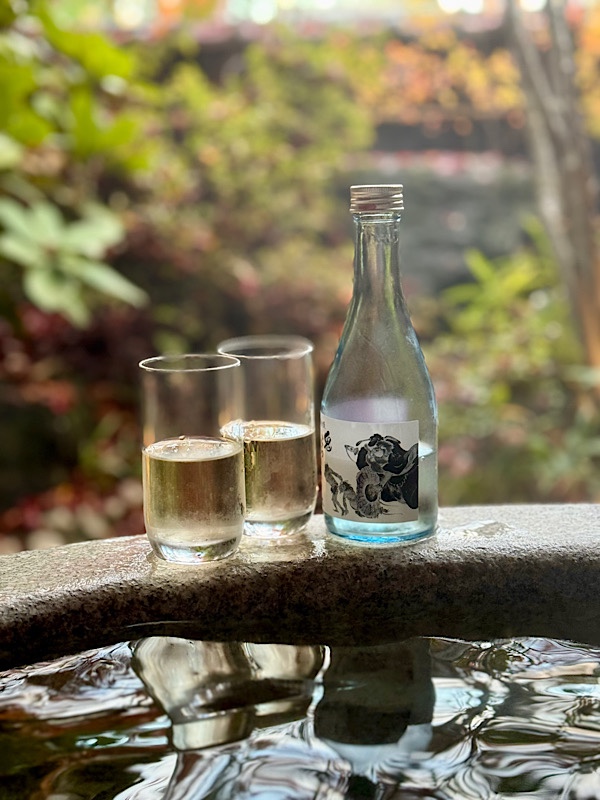
 The ryokan has some lovely open spaces that guests can use if they wish, but we hardly saw anyone – in fact with the private onsen in our little garden, and having a meal in a private dining room, we could swear for most of our visit that there was hardly anyone else staying at the inn. The only give away was the shoes all lined up in the morning as people were getting ready to check out or go to town for the day. There are no shoes worn on the tatami mats here, only tabi socks. Even the staff are silently walking up and down the hallways in socks.
The ryokan has some lovely open spaces that guests can use if they wish, but we hardly saw anyone – in fact with the private onsen in our little garden, and having a meal in a private dining room, we could swear for most of our visit that there was hardly anyone else staying at the inn. The only give away was the shoes all lined up in the morning as people were getting ready to check out or go to town for the day. There are no shoes worn on the tatami mats here, only tabi socks. Even the staff are silently walking up and down the hallways in socks. Dinner was a multiple course kaiseki meal – starters consisted of:
Dinner was a multiple course kaiseki meal – starters consisted of: Matsutake mushroom soup with shrimp, pike and eel.
Matsutake mushroom soup with shrimp, pike and eel. Sashimi – roasted Hida beef with plum flavoured onion sauce.
Sashimi – roasted Hida beef with plum flavoured onion sauce.  Sashimi – amberjack and mackerel.
Sashimi – amberjack and mackerel. Local saké.
Local saké.  Steam turnip with mushrooms and lily root, stuffed with ginkgo nut.
Steam turnip with mushrooms and lily root, stuffed with ginkgo nut. Hida beef steak with vegetables.
Hida beef steak with vegetables. Grilled freshwater sweetfish stuffed with roe.
Grilled freshwater sweetfish stuffed with roe. Whipped pumpkin topped with abalone.
Whipped pumpkin topped with abalone. Local steamed rice, miso soup with mushrooms, tofu and pickles.
Local steamed rice, miso soup with mushrooms, tofu and pickles. Sweet potato cake and seasonal fruits… I love the little maples leaves they are decorating our meals with seeing as it is autumn. You just know someone in the kitchen is tasked with finding the prettiest leaves for the job.
Sweet potato cake and seasonal fruits… I love the little maples leaves they are decorating our meals with seeing as it is autumn. You just know someone in the kitchen is tasked with finding the prettiest leaves for the job.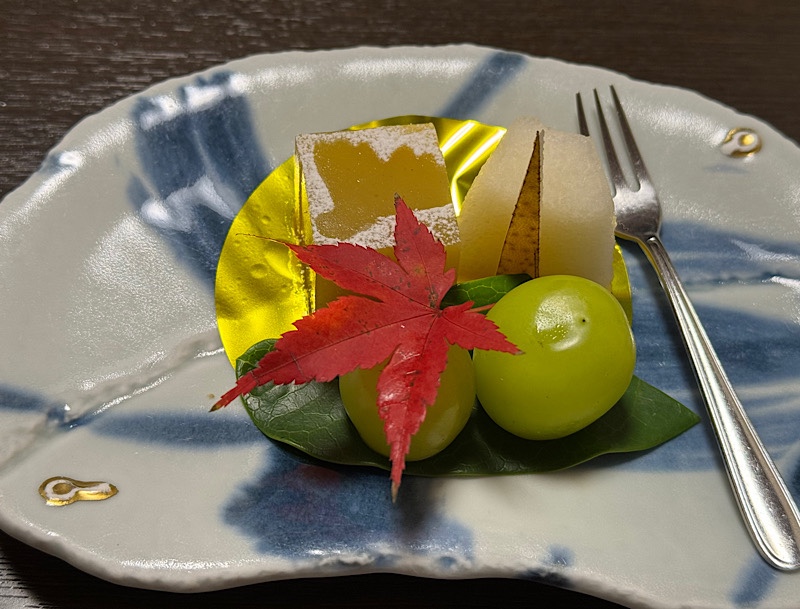
 After such an amazing meal, we let our dinner settle and then it was back into the onsen again… I could really get used to this. You can just feel the tension draining away from all your muscles, and even though the air temperature was quite cold, the water was so inviting that you barely noticed it.
After such an amazing meal, we let our dinner settle and then it was back into the onsen again… I could really get used to this. You can just feel the tension draining away from all your muscles, and even though the air temperature was quite cold, the water was so inviting that you barely noticed it.
 Breakfast was another lavish affair of itty bitty dishes filled with very tasty things!
Breakfast was another lavish affair of itty bitty dishes filled with very tasty things! The menu was rather more casual for breakfast, which was excellent. 🙂
The menu was rather more casual for breakfast, which was excellent. 🙂 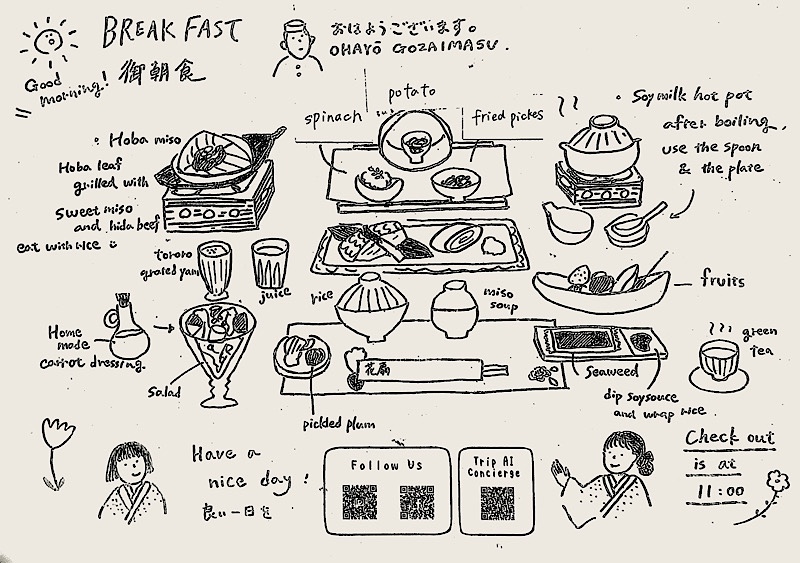
 When we returned from doing transport stuff in the city, I had an opportunity to pop into the ladies public onsen in the hotel. Not all rooms here have a private bath like we have booked and there is a men’s and ladies onsen baths that swap over day to day so you can try the different bathing spaces. There were dressing tables for about six people, all full of amenities – soaps, lotions, shampoos, conditioners etc.
When we returned from doing transport stuff in the city, I had an opportunity to pop into the ladies public onsen in the hotel. Not all rooms here have a private bath like we have booked and there is a men’s and ladies onsen baths that swap over day to day so you can try the different bathing spaces. There were dressing tables for about six people, all full of amenities – soaps, lotions, shampoos, conditioners etc.  A space for dressing and changing and to store your clothing while you bathed.
A space for dressing and changing and to store your clothing while you bathed. A post-onsen relaxation space where you could have complimentary cold beverages and even try out a massage chair.
A post-onsen relaxation space where you could have complimentary cold beverages and even try out a massage chair. And, as the onsen was unoccupied I was able to take a photograph of the baths here. The Japanese are very ritualistic about their baths – which I love, but one of their customs is that tattooed peoples re not allowed in public onsens. Some ryokan will make exceptions for their Western guests (as we are highly unlikely to be connected to local organised crime gangs) but others are very strict and ask you to cover your ink. I have no idea what the policy is here – I didn’t ask… but it was the primarily motivator for booking a room with a private bath. That and bathing with strange people who you don’t share a common language with gets pretty boring pretty fast.
And, as the onsen was unoccupied I was able to take a photograph of the baths here. The Japanese are very ritualistic about their baths – which I love, but one of their customs is that tattooed peoples re not allowed in public onsens. Some ryokan will make exceptions for their Western guests (as we are highly unlikely to be connected to local organised crime gangs) but others are very strict and ask you to cover your ink. I have no idea what the policy is here – I didn’t ask… but it was the primarily motivator for booking a room with a private bath. That and bathing with strange people who you don’t share a common language with gets pretty boring pretty fast.  So we didn’t make use of the public onsen and made use of our private garden bath again! I’m so enamoured of this little garden oasis – I took so many photos.
So we didn’t make use of the public onsen and made use of our private garden bath again! I’m so enamoured of this little garden oasis – I took so many photos.  Oh more saké before dinner? Don’t mind if I do!
Oh more saké before dinner? Don’t mind if I do! Prior to arriving I had requested the special Hida beef kaiseki meal on our second night. It was at a small additional cost, but given Gifu is so famous for their Hida beef, we felt it would be worth it. Kyaka kept referring to it as the ‘Too Much Beef Dinner’, which we thought was cute.
Prior to arriving I had requested the special Hida beef kaiseki meal on our second night. It was at a small additional cost, but given Gifu is so famous for their Hida beef, we felt it would be worth it. Kyaka kept referring to it as the ‘Too Much Beef Dinner’, which we thought was cute.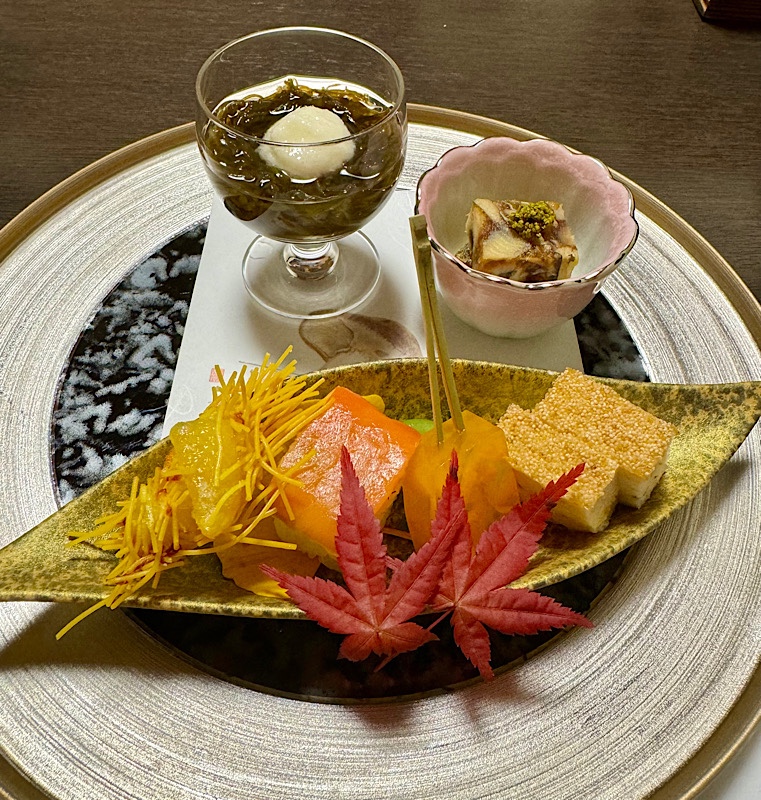
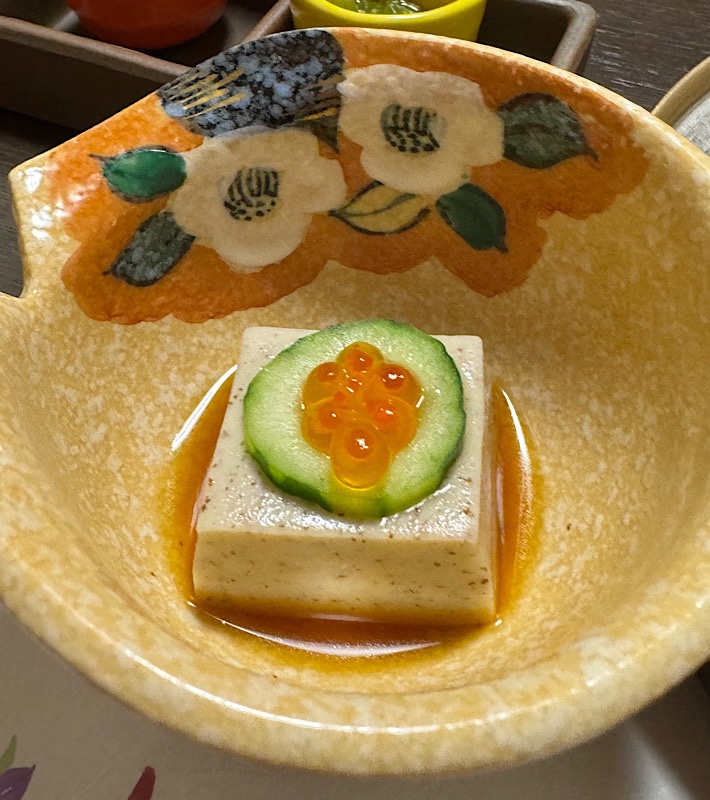
 A rare selfie taken in our private dining room… the ‘glow’ is the saké, of course. 😛
A rare selfie taken in our private dining room… the ‘glow’ is the saké, of course. 😛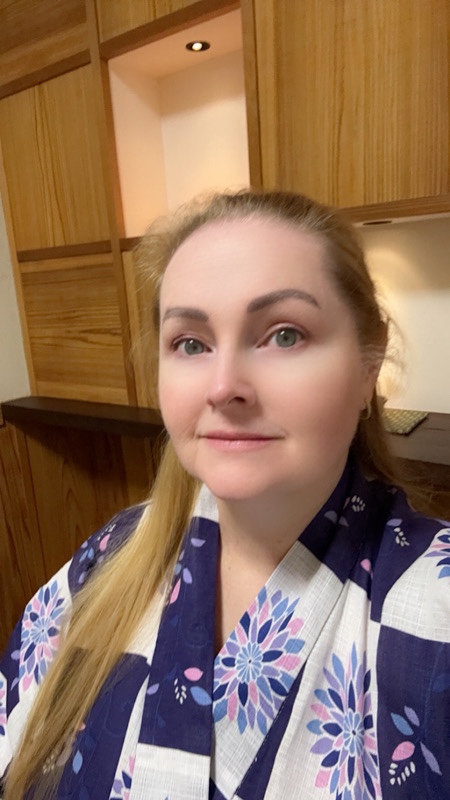


 Hida beef steak
Hida beef steak




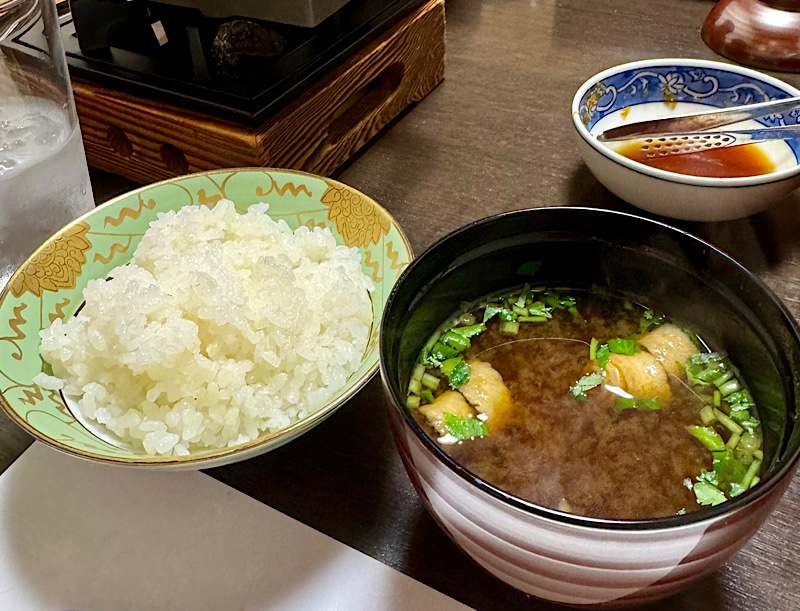

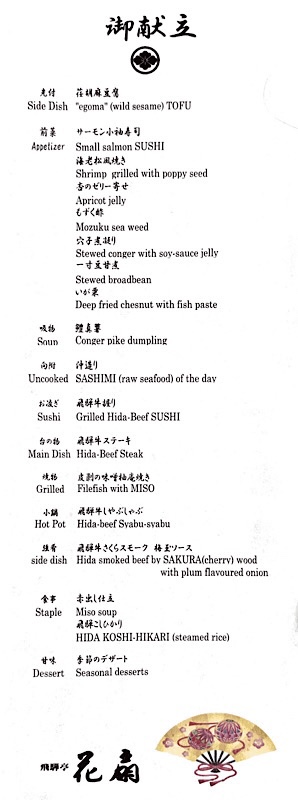

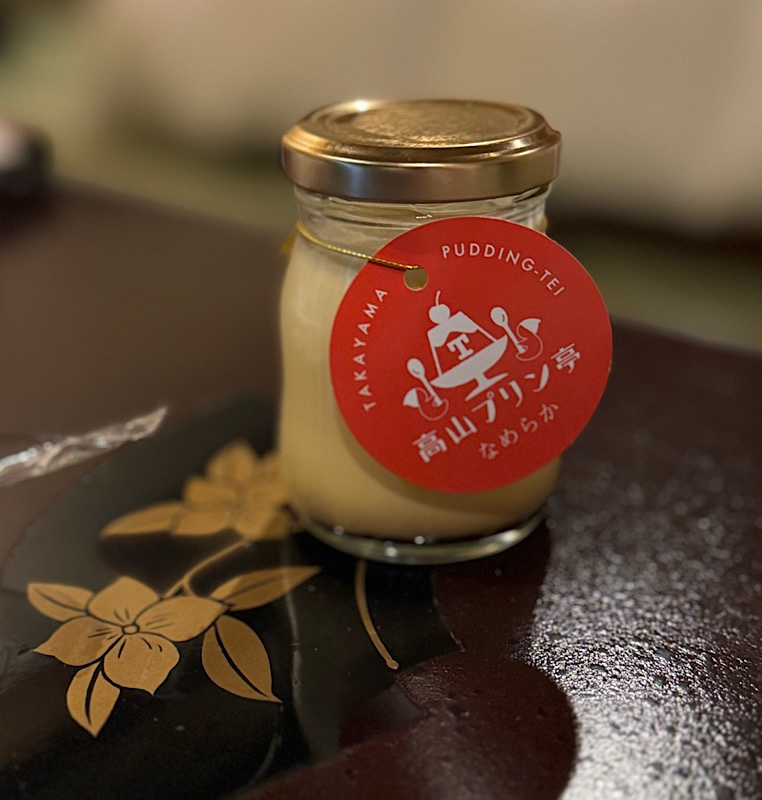
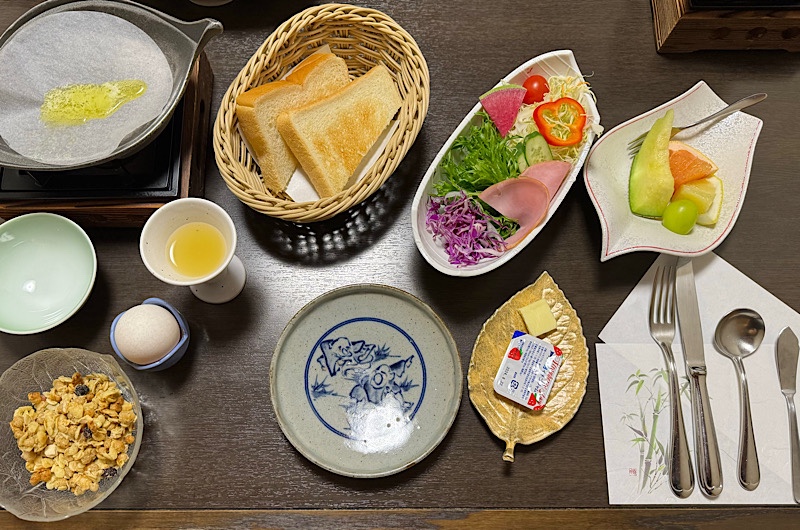
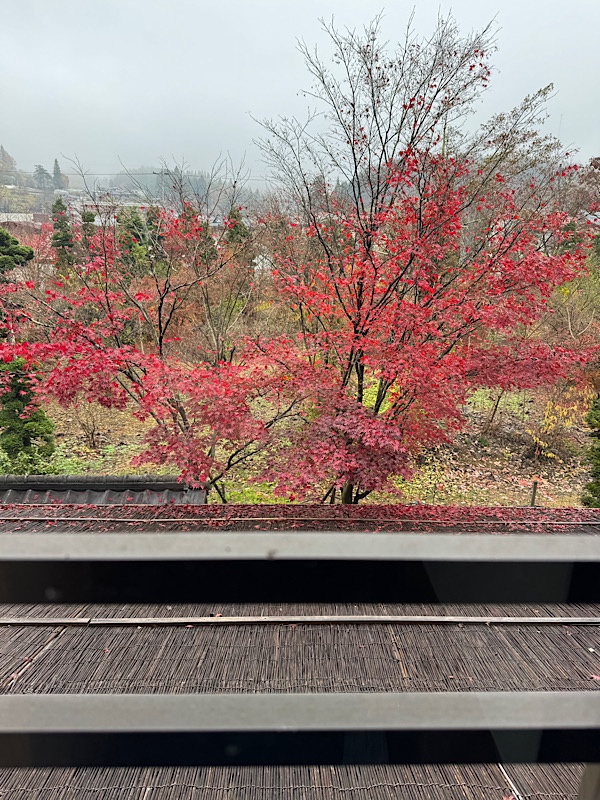
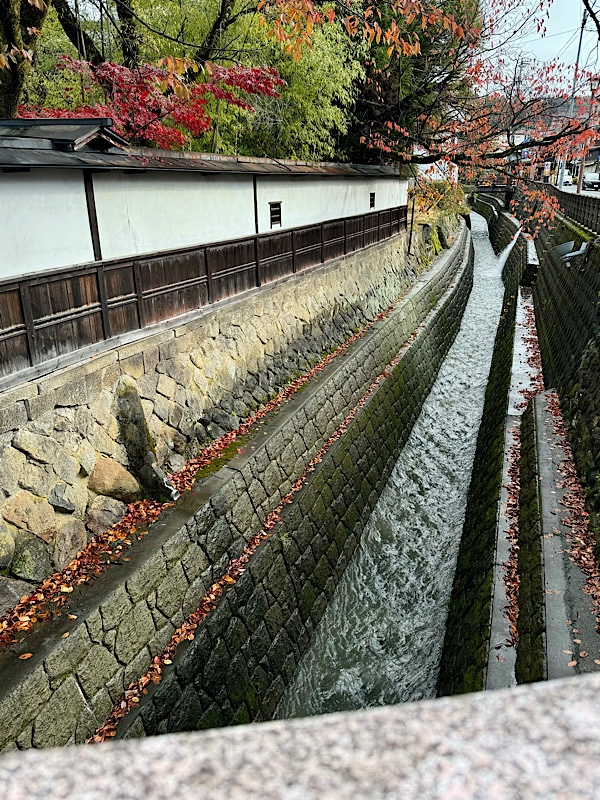 Takayama’s Old Town district isn’t very big so a few hours is a goodly amount of time to spend wandering the streets here – unless you get side tracked.
Takayama’s Old Town district isn’t very big so a few hours is a goodly amount of time to spend wandering the streets here – unless you get side tracked. There were chop stick shops, LOADS of sweets, biscuits and lollies for sale, puddings, beef stores, fans, glassware, ceramics, and cutesy as hell Japanese kitch.
There were chop stick shops, LOADS of sweets, biscuits and lollies for sale, puddings, beef stores, fans, glassware, ceramics, and cutesy as hell Japanese kitch. 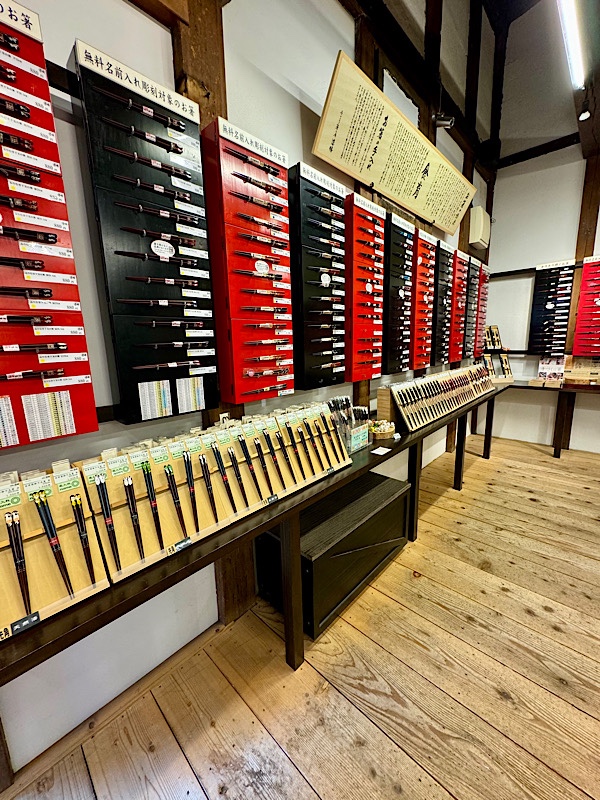 Cute little glass chopstick rests… I nearly bought a set to bring home but while the chopsticks I bought home from Kanazawa back in 2015 are probably the most used and useful souvenir I have ever bought from anywhere, we tend not to set the table too fancy when we are having Japanese at home. So they probably wouldn’t end up getting used much.
Cute little glass chopstick rests… I nearly bought a set to bring home but while the chopsticks I bought home from Kanazawa back in 2015 are probably the most used and useful souvenir I have ever bought from anywhere, we tend not to set the table too fancy when we are having Japanese at home. So they probably wouldn’t end up getting used much. 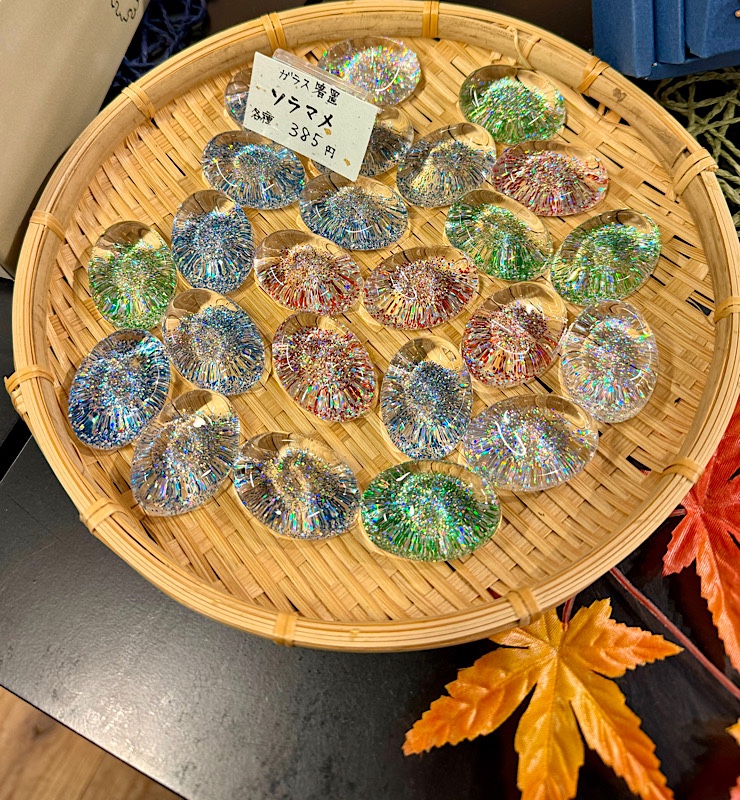
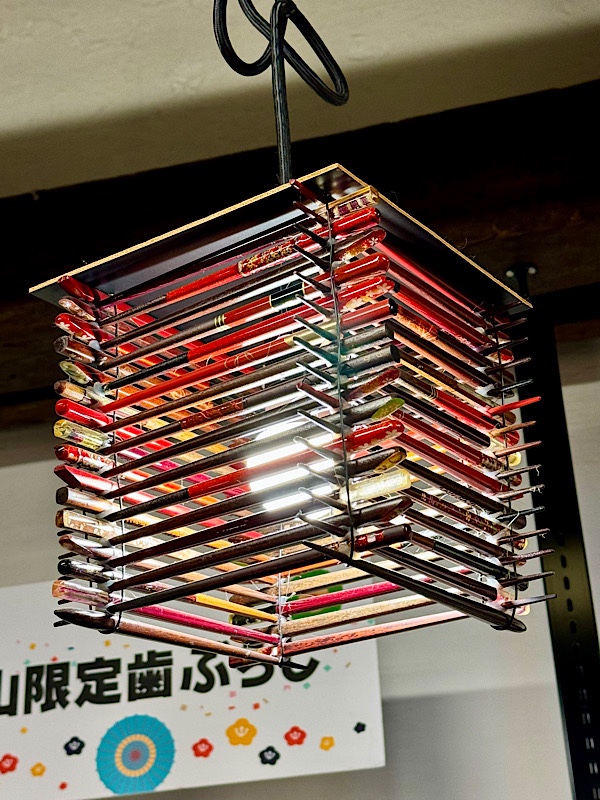 These fans remind me of the hundreds of fan shops all over Kyoto… Takayama is sometimes called ‘Little Kyoto’, as its old town district is relatively well kept.
These fans remind me of the hundreds of fan shops all over Kyoto… Takayama is sometimes called ‘Little Kyoto’, as its old town district is relatively well kept. 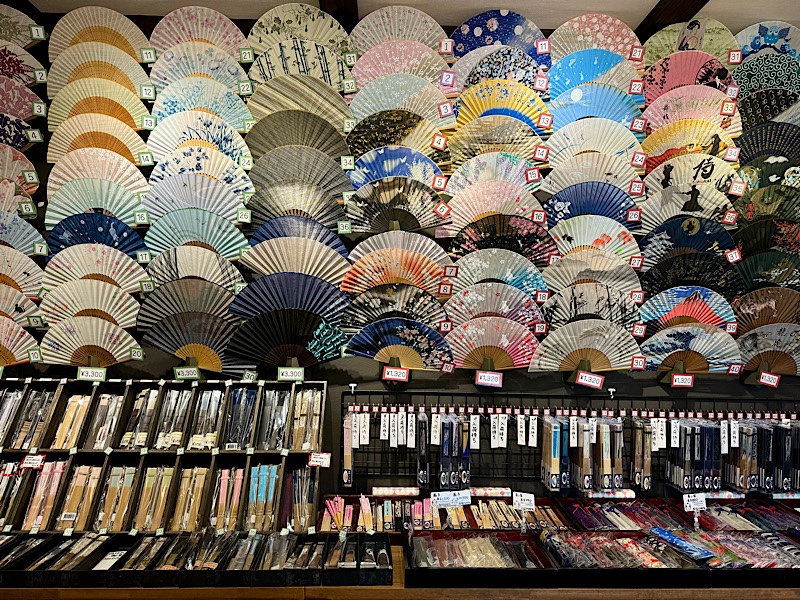 Takayama is also really well known for its Hida beef… this is a Hida beef bun – the type you usually get full of pork. Mr K felt that he just *had* to get one and it I stole a bite, it was really tasty.
Takayama is also really well known for its Hida beef… this is a Hida beef bun – the type you usually get full of pork. Mr K felt that he just *had* to get one and it I stole a bite, it was really tasty. 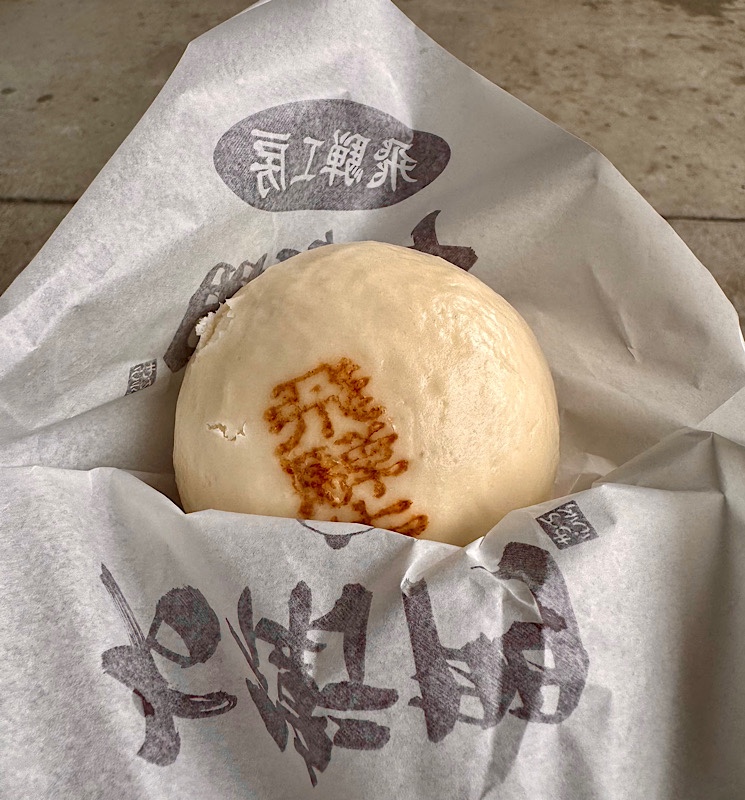
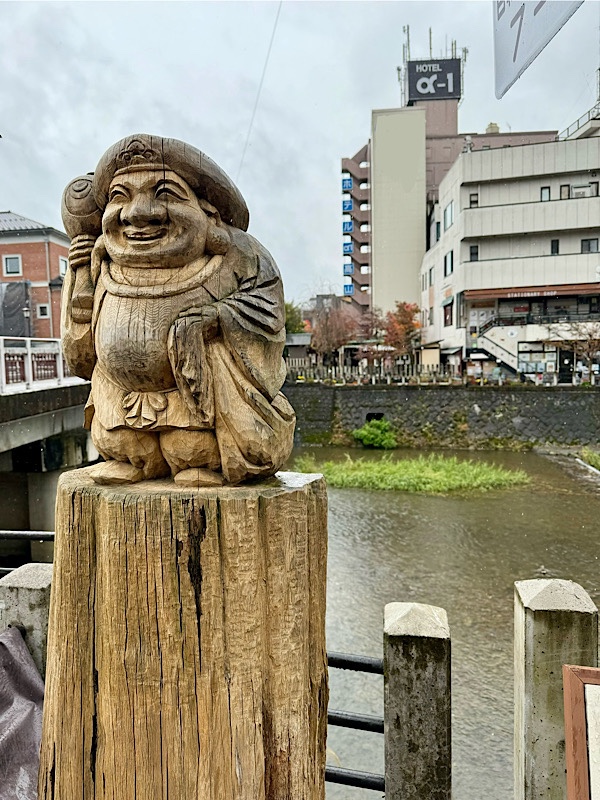 This guy actually represents Daikoku who is one of the Seven Gods of Fortune. This god is said to be a fusion of the mythological creator of Japan, known as Okuninushi no Mikoto, and an Indian God…. weird combo.
This guy actually represents Daikoku who is one of the Seven Gods of Fortune. This god is said to be a fusion of the mythological creator of Japan, known as Okuninushi no Mikoto, and an Indian God…. weird combo.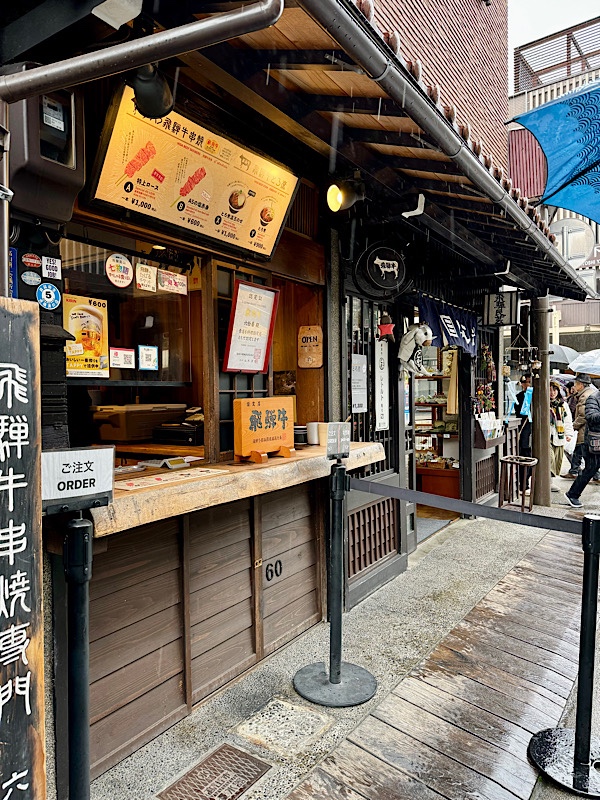 This is his, ‘I’m not working for ten minutes together, and there is beer and beef!’, face.
This is his, ‘I’m not working for ten minutes together, and there is beer and beef!’, face.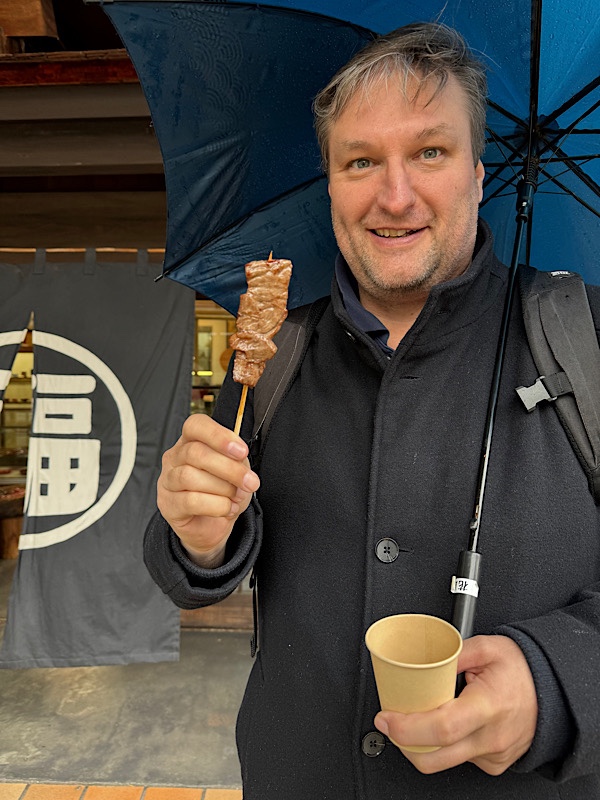
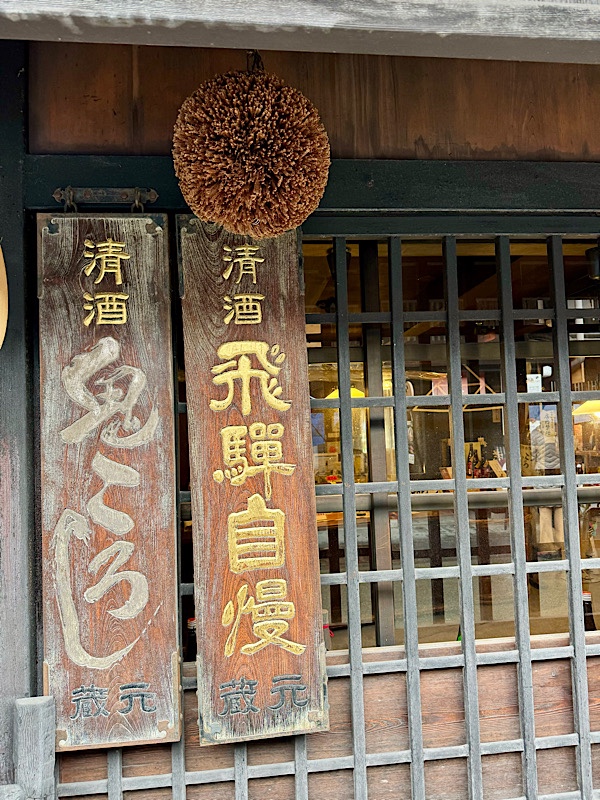 Why hello? This is where I parked my car!
Why hello? This is where I parked my car!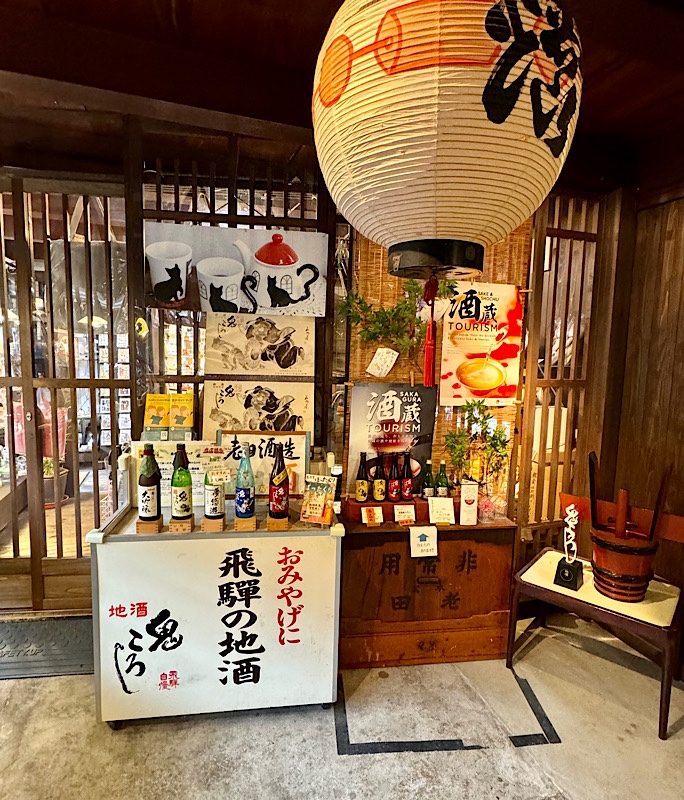

 Anyway… what was Hello Kitty doing in the middle of my saké adventure, anyway? I think we accidentally wandered into saké heaven… there are so many breweries here that there are walking tours and special maps showing you which brewery is where.
Anyway… what was Hello Kitty doing in the middle of my saké adventure, anyway? I think we accidentally wandered into saké heaven… there are so many breweries here that there are walking tours and special maps showing you which brewery is where.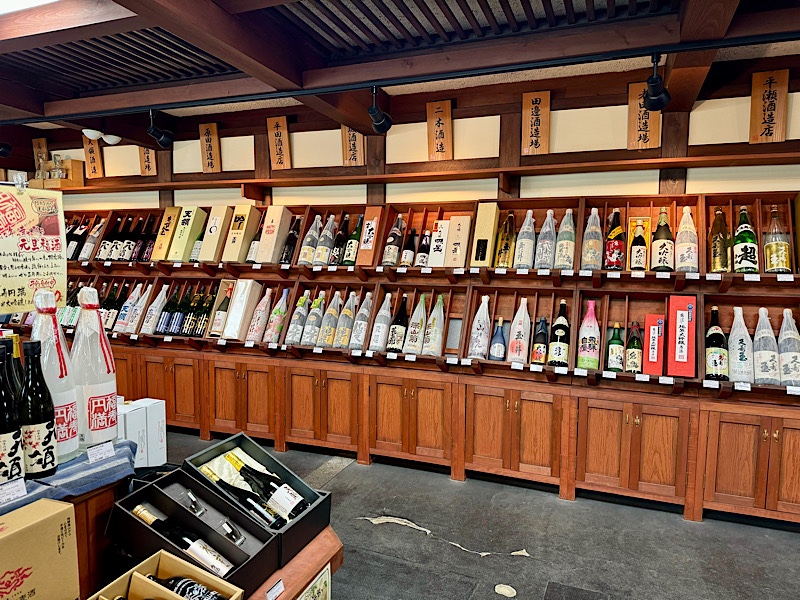
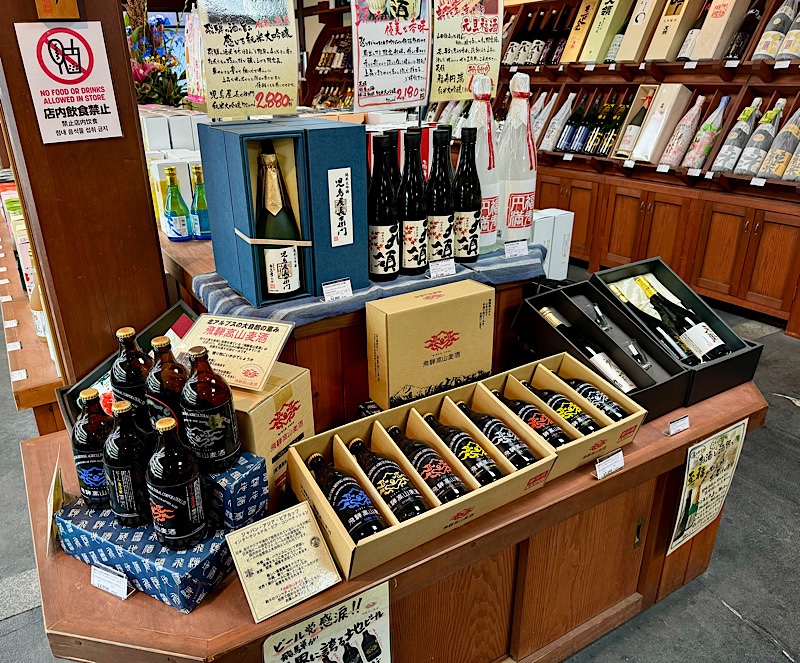

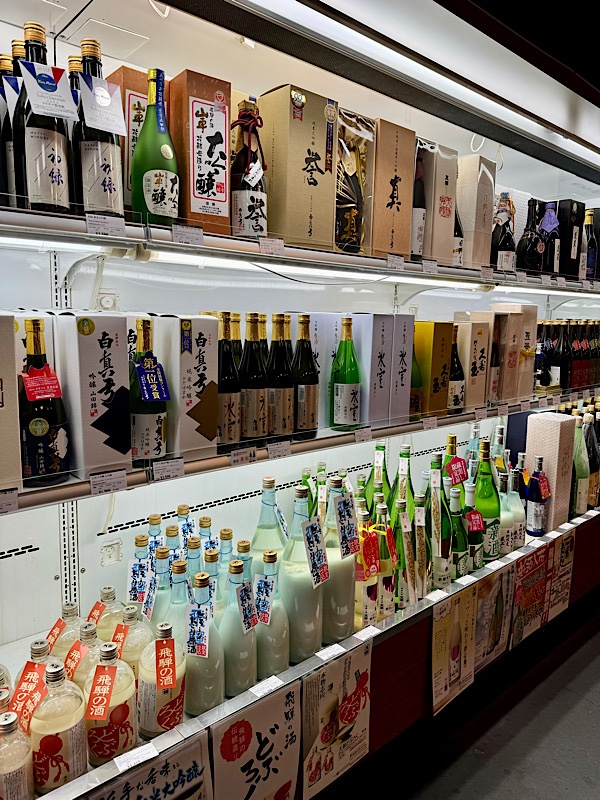


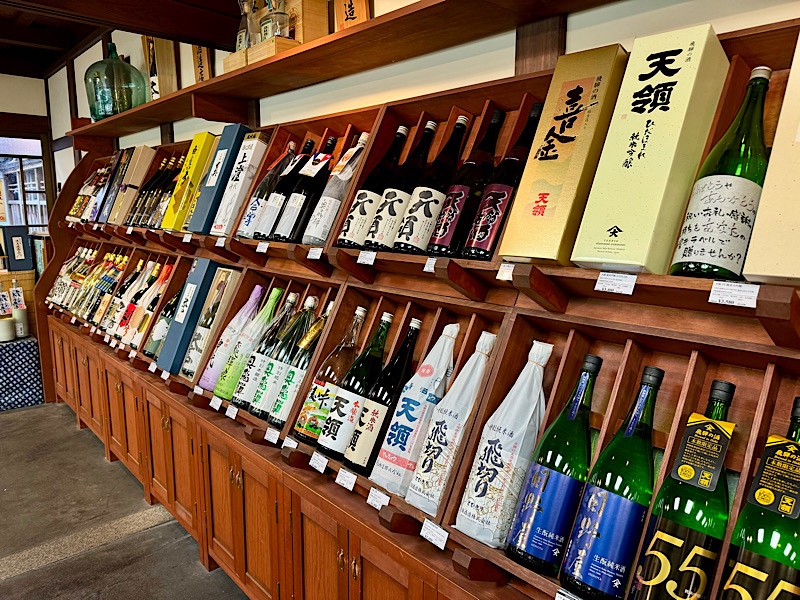
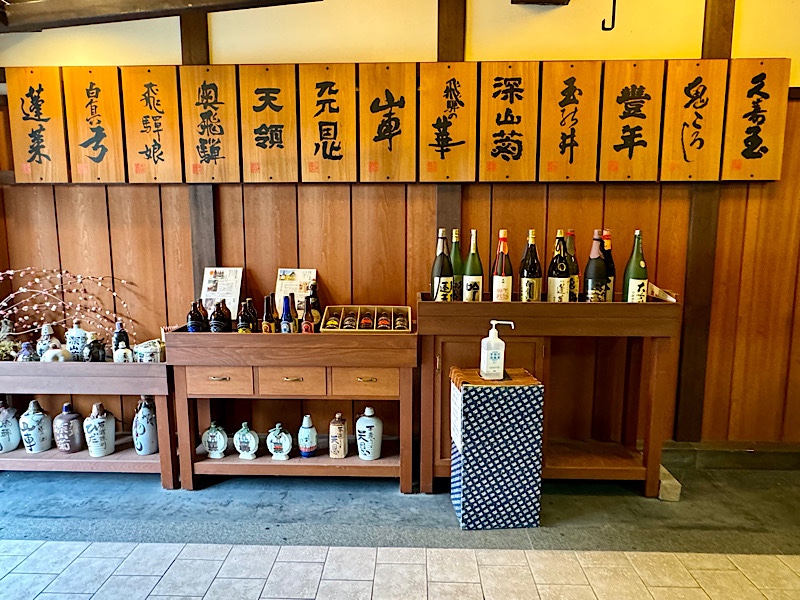 Okay, so that was just one Takayama saké store – it isn’t even one of their brewery store fronts! >.> This may take longer than we anticipated…
Okay, so that was just one Takayama saké store – it isn’t even one of their brewery store fronts! >.> This may take longer than we anticipated…  Oita Sake Brewery Kamisannomachi *(I think… by the time you get to the end of this you’ll see where the confusion is creeping in!)
Oita Sake Brewery Kamisannomachi *(I think… by the time you get to the end of this you’ll see where the confusion is creeping in!) This place was directly across the street from the Takayama Cafe…e
This place was directly across the street from the Takayama Cafe…e
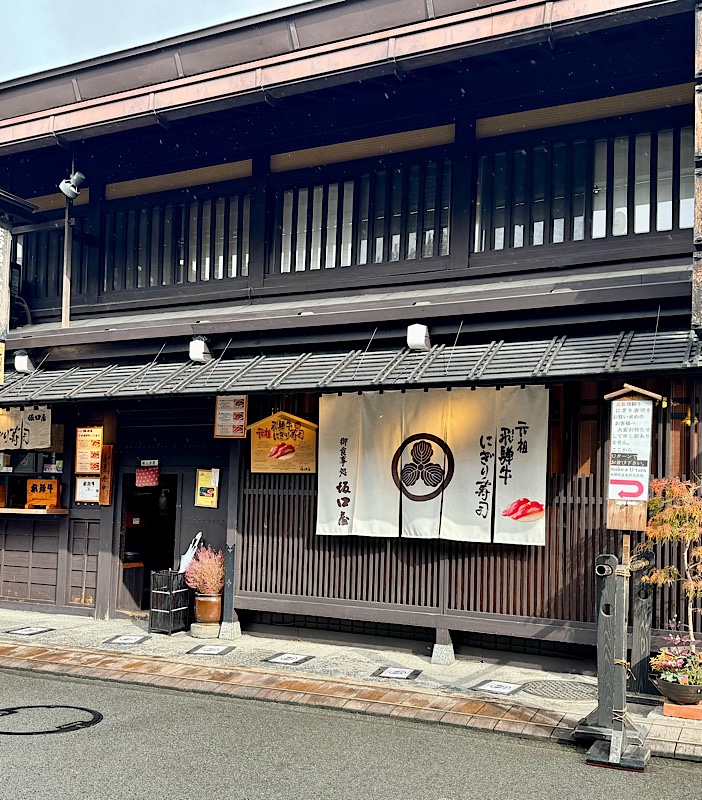
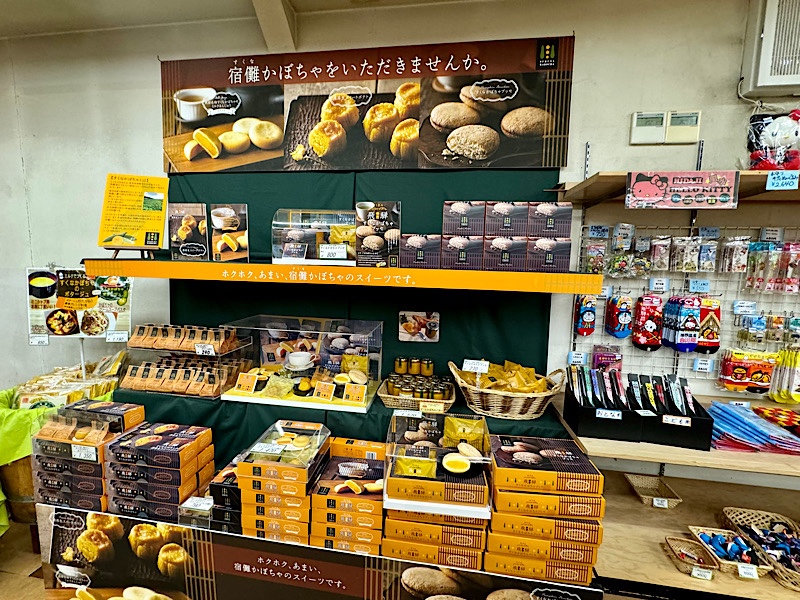
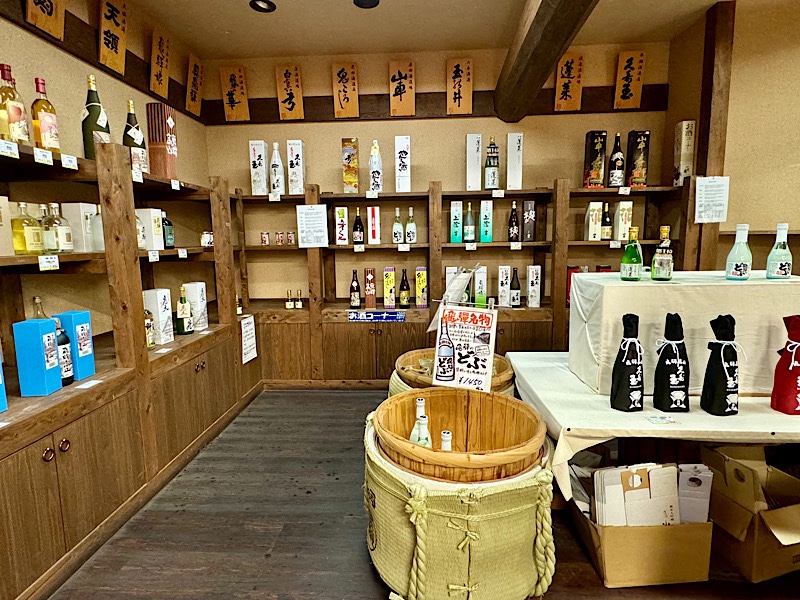
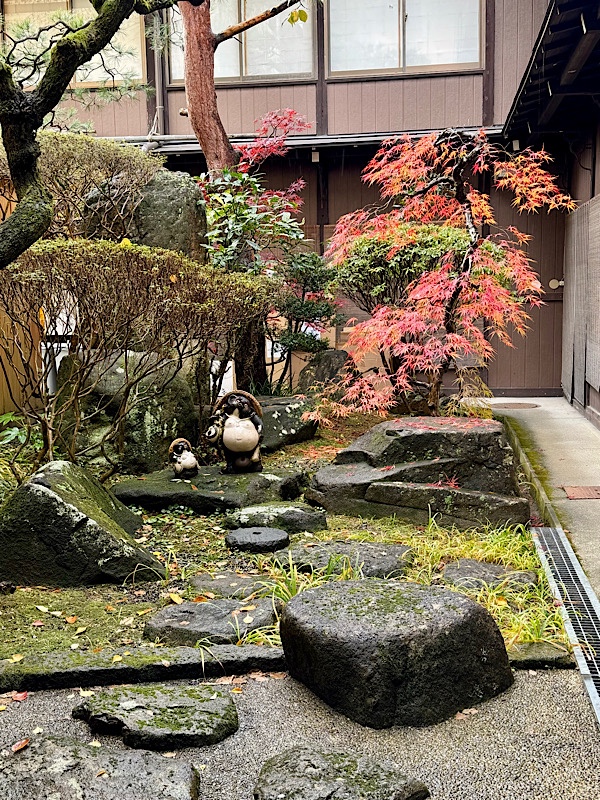
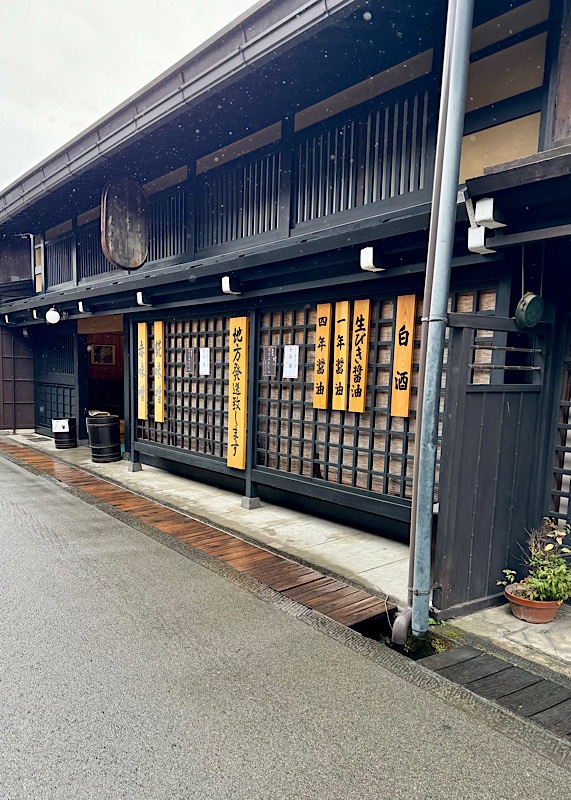
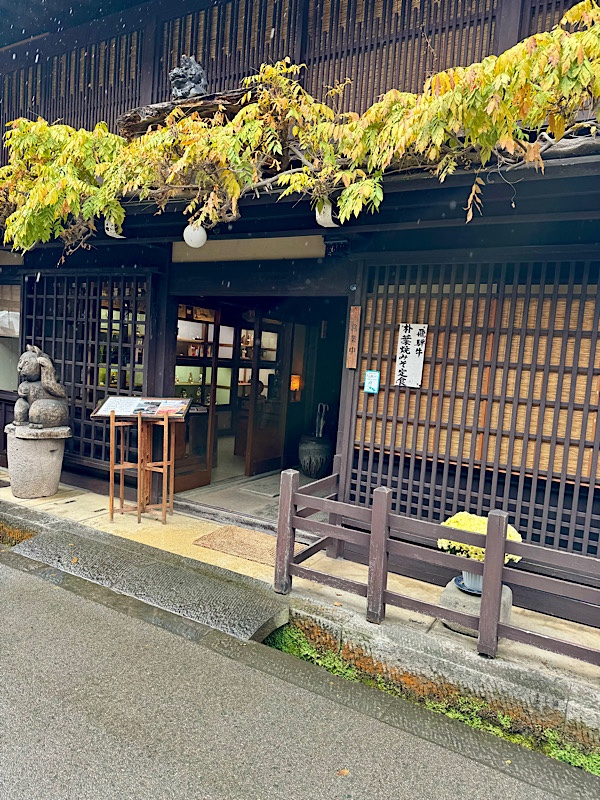 Funasaka Saké Brewery…
Funasaka Saké Brewery…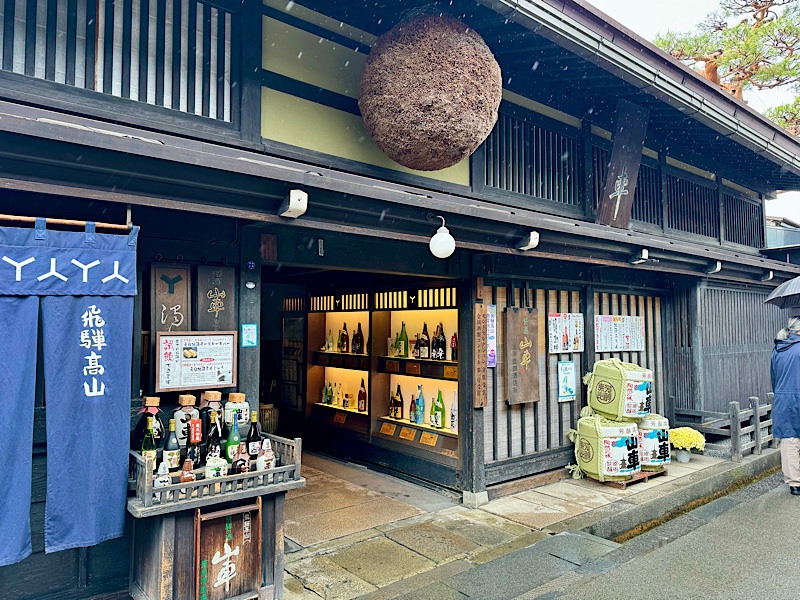 This place was great – you pay 450JPY for a little cup and you can fill it 12 times from 12 different bottles in their range that are kept in a big fridge you can access.
This place was great – you pay 450JPY for a little cup and you can fill it 12 times from 12 different bottles in their range that are kept in a big fridge you can access.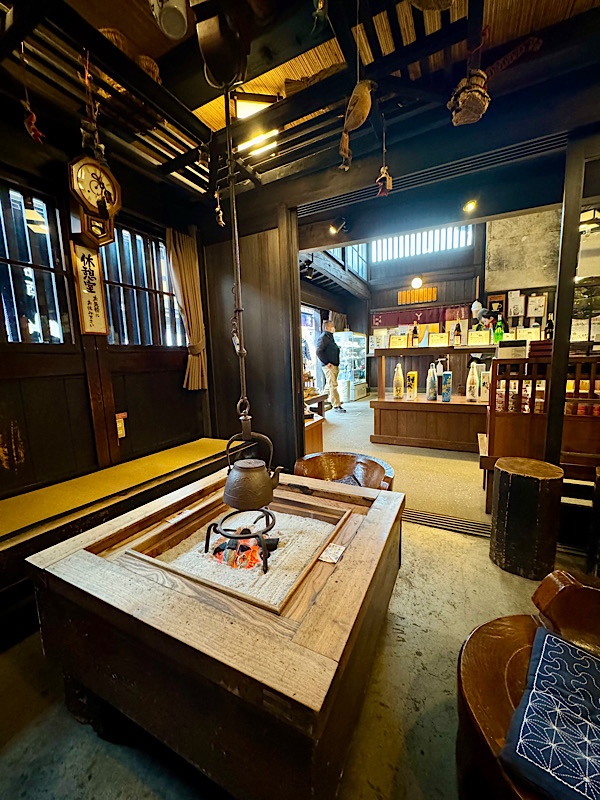

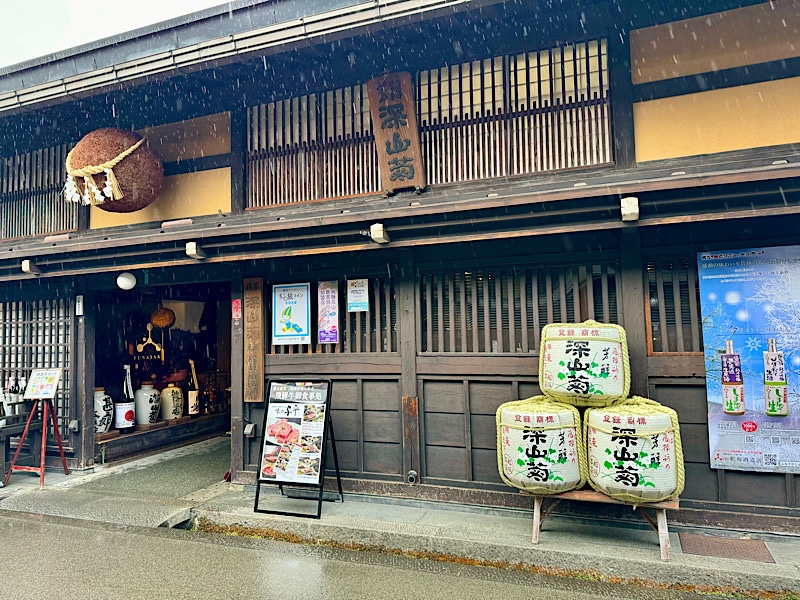
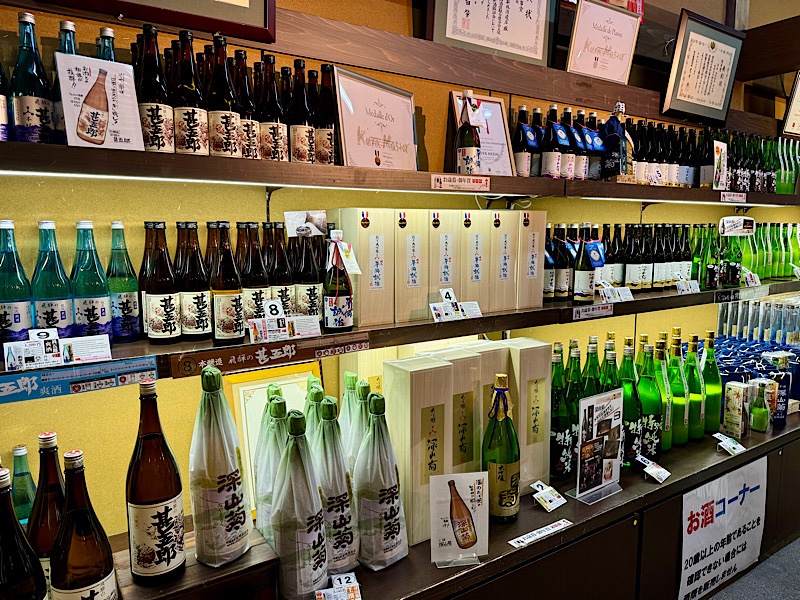
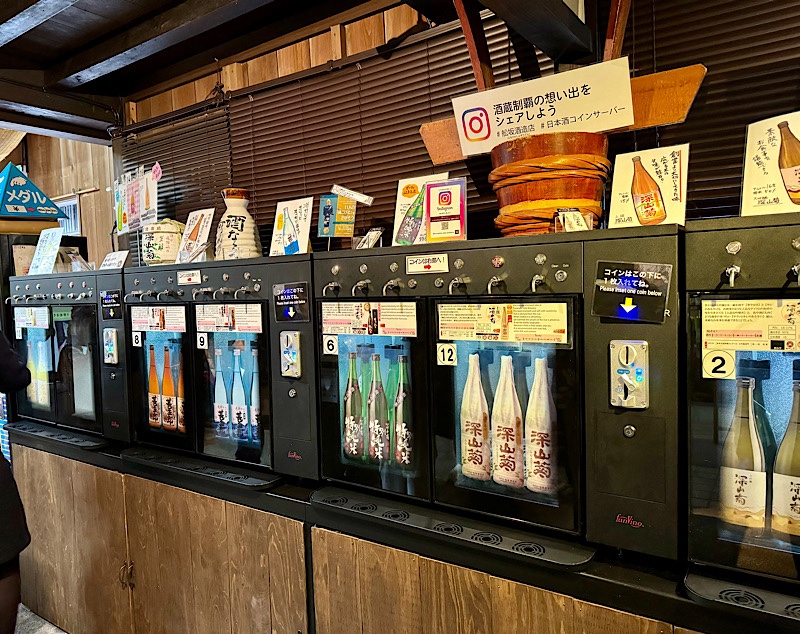
 Matsuzaka Saké…
Matsuzaka Saké…  So many people lining up for the token machine!
So many people lining up for the token machine!
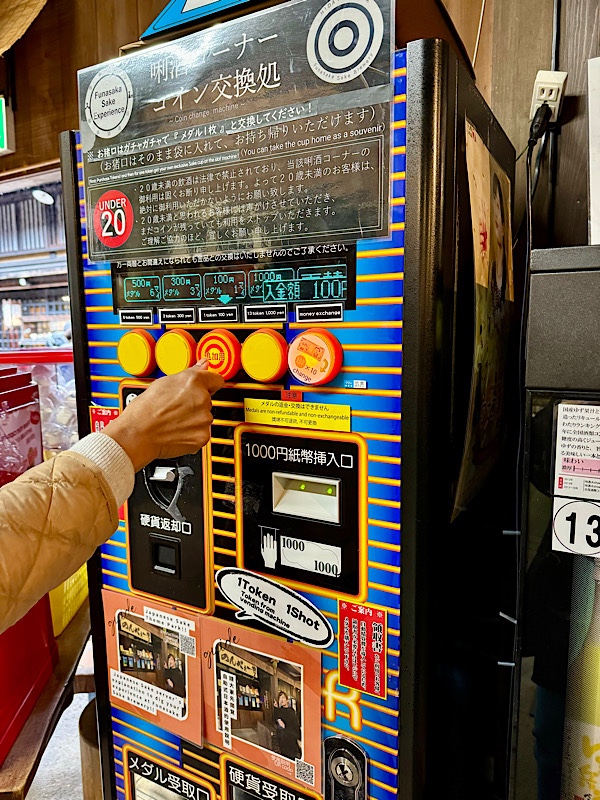 It was so easy to just hook into this… $10 later and you’re really quite toasted.
It was so easy to just hook into this… $10 later and you’re really quite toasted.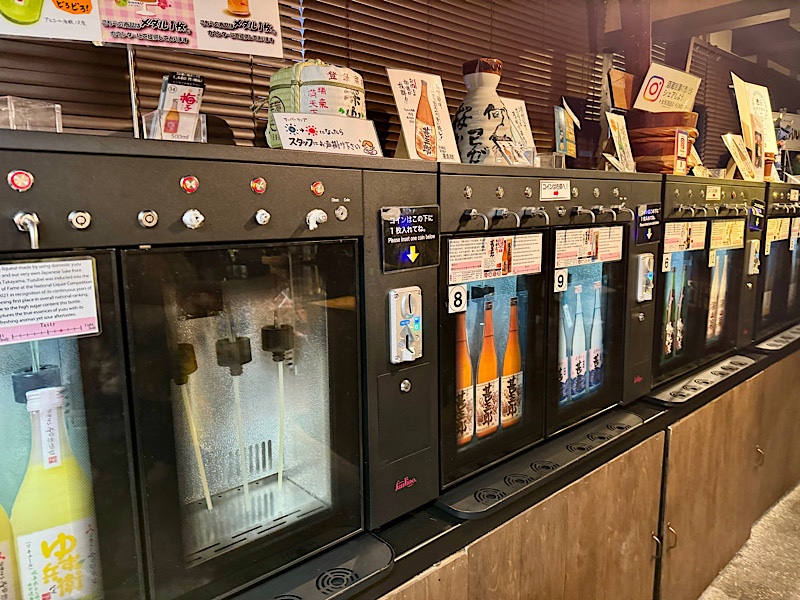 Quaffable stuff and well worth a stop!
Quaffable stuff and well worth a stop! Ummm.. Kawashiri Brewery I think? :/
Ummm.. Kawashiri Brewery I think? :/ 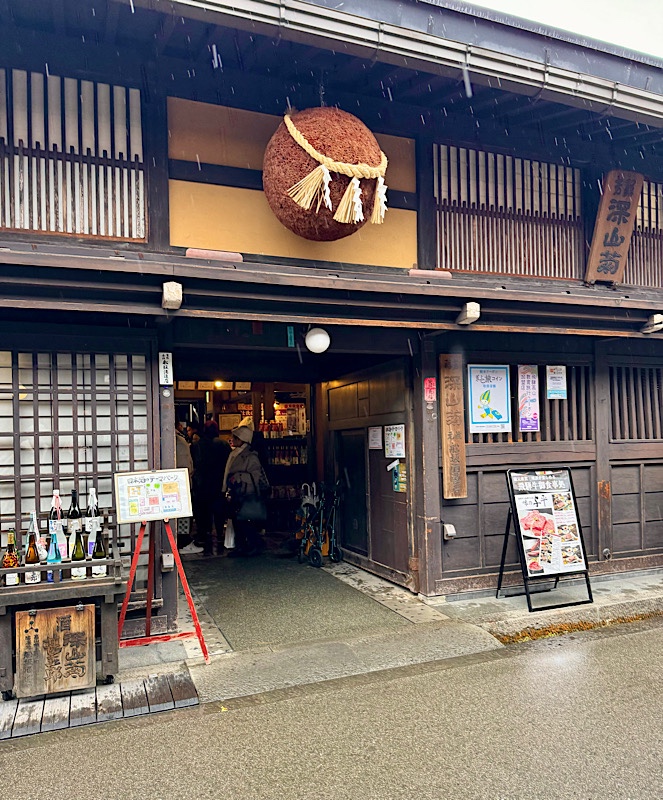 It was about this point that we decided we should get back to our accom as we had more work to do and I was rapidly ending up in a state where I wasn’t going to useful at all!
It was about this point that we decided we should get back to our accom as we had more work to do and I was rapidly ending up in a state where I wasn’t going to useful at all!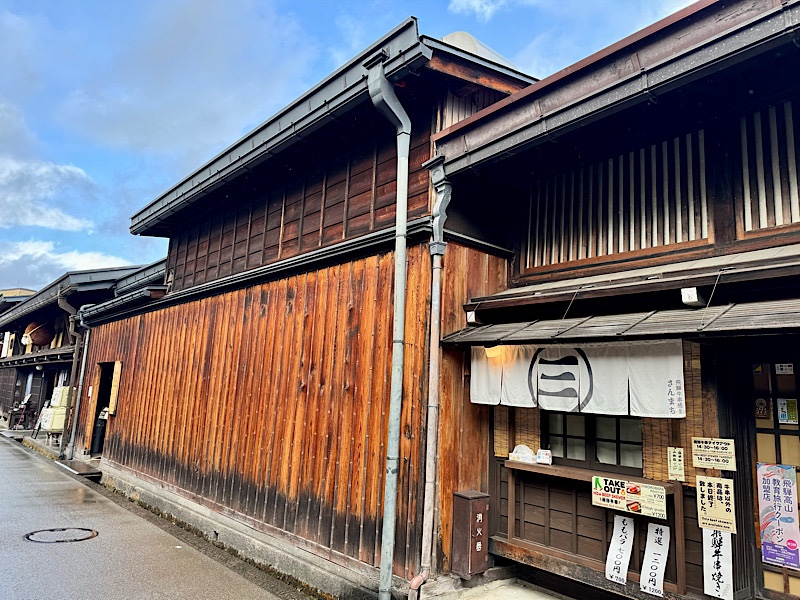
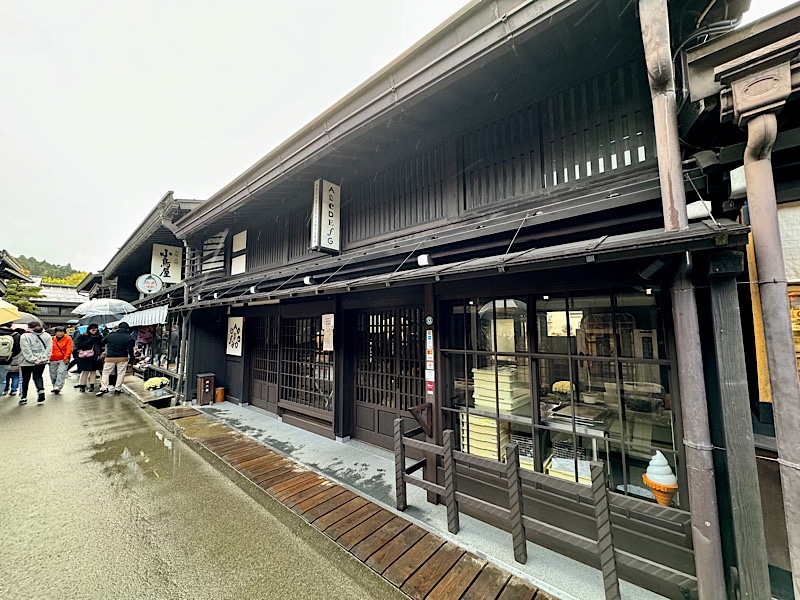

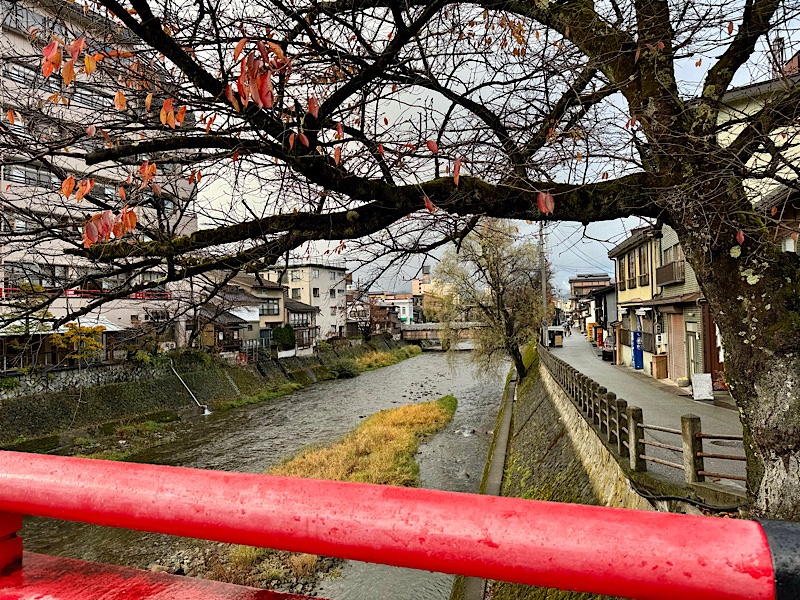
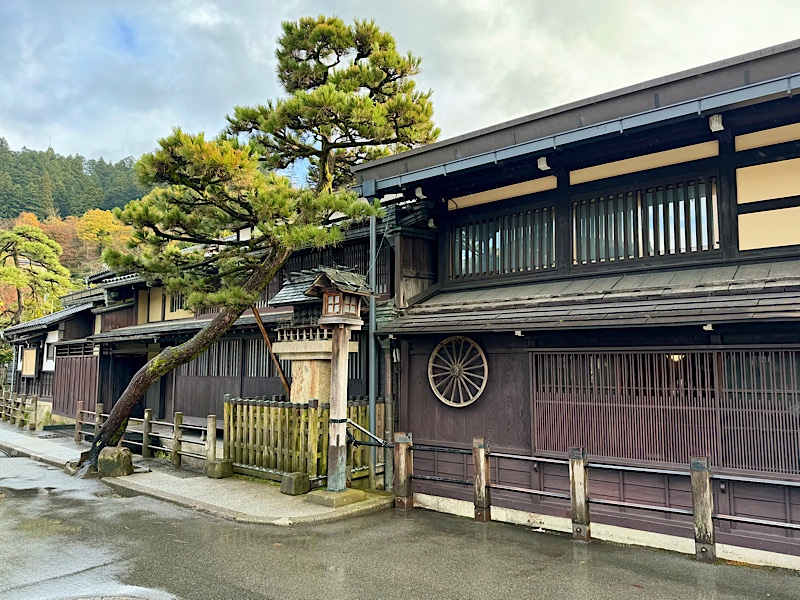 Gorgeous little town with heaps to see. And we didn’t even touch on their weird retro museums and other offerings.
Gorgeous little town with heaps to see. And we didn’t even touch on their weird retro museums and other offerings.